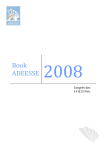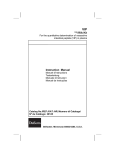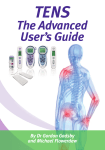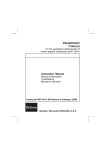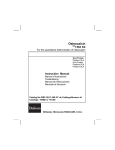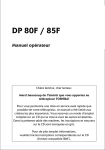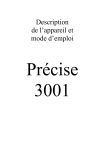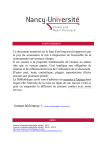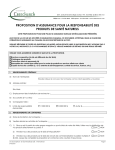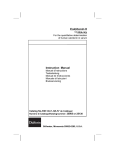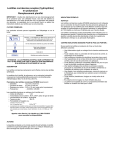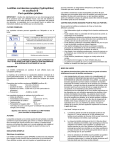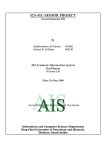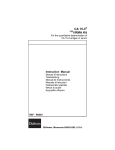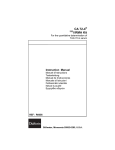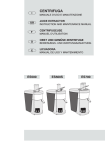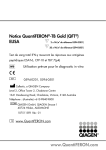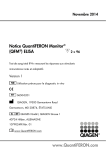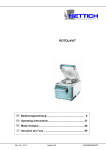Download 125I RIA Kit Instruction Manual
Transcript
ACTH 125 I RIA Kit For the quantitative determination of human ACTH in EDTA plasma Instruction Manual Manuel d’Instructions Testanleitung Manuale di Istruzioni REF: 24130 Stillwater, Minnesota 55082-0285, U.S.A. Printed For Final Review: 10/10/03 ECO Number: 27339 08:55 AM TABLE OF CONTENTS English ................................................................................................................ Page 1 Français .....................................................................................................................12 Deutsch .......................................................................................................................23 Italiano.........................................................................................................................35 Printed For Final Review: 10/10/03 ECO Number: 27339 08:55 AM ADRENOCORTICOTROPIC HORMONE RADIOIMMUNOASSAY 1. INTENDED USE FOR IN VITRO DIAGNOSTIC USE. This kit contains instructions and materials for the quantitative determination of human ACTH in EDTA plasma by radioimmunoassay (RIA). 2. SUMMARY AND EXPLANATION ACTH is a 39 amino acid pituitary hormone with the following structure: NH2-Ser-Tyr-Ser-Met-Glu-His-Phe-Arg-Trp-Gly-Lys-Pro-ValGly-Lys-Lys-Arg-Arg-Pro-Val-Lys-Val-Tyr-Pro-Asn-GlyAla-Glu-Asp-Glu-Ser-Ala-Glu-Ala-Phe-Pro-Leu-Glu-Phe-OH The sequence 1-13 is the same as alpha melanocyte stimulating hormone. Sequence 1-24 is considered the active portion of the molecule. Sequence 18-39 is known as clip or corticotropin-like intermediate lobe peptide.1 The molecule is generally a basic protein and quite labile to the action of peptidases. Since ACTH readily binds to glass and associates with serum proteins, a special buffer preparation is necessary to ensure preservation of ACTH and to reduce nonspecific binding.1, 2 ACTH stimulates the secretion of cortisol from the adrenal gland and is under control of a feedback mechanism, forming a tightly controlled loop between the hypothalamus, pituitary, and adrenal glands.3, 4 Two factors in the hypothalamus will stimulate ACTH release. One is vasopressin, a well known peptide, and the other is a lesser known substance, CRF or corticotropin releasing factor. Vasopressin infusion is a potentially useful provocative test; however, it has certain dangers and must be used cautiously. ACTH measurement is a clinically useful tool in the assessment of adrenal and pituitary insufficiency.5 It is also useful in assessment of Cushing’s syndrome, whether related to pituitary or adrenal tumors.6, 7 Further information on the use of the DiaSorin ACTH assay is available upon request. 3. PRINCIPLE OF THE ASSAY The DiaSorin ACTH assay is an equilibrium radioimmunoassay which can be performed by one of two methods. In Option A, sample, first antibody and tracer are combined and incubated for 16-24 hours at 2-8°C. A pre-precipitated second antibody complex is added to separate the bound from free tracer. The assay can then be centrifuged and decanted after a 15 minute incubation at 20-25°C. In Option B, sample, first antibody, and tracer are combined and incubated for 3 hours at 2-8°C. A pre-precipitated second antibody complex is added to separate the bound from free tracer. The assay can then be centrifuged and decanted after a 15 minute incubation at 20-25°C. The 3 hour option is less sensitive than the overnight procedure, and the results obtained will be slightly higher. Quality control will be performed at DiaSorin using only Option A. 1 Printed For Final Review: 10/10/03 ECO Number: 27339 4. 08:55 AM REAGENT PROVIDED IN THE KIT ACTH Calibrator 0 ACTH Calibrators (1-5) ACTH Antiserum 125 I ACTH Precipitating Complex (GAR-PPT) ACTH Controls level 1 and 2 Number of tests 1 vial/3 mL 5 vials/1.0 mL 1 vial/14 mL 1 vial/14 mL 1 vial/ 35 mL 2 vials/1.0 mL 65 1 vial/3 mL 5 vials/1.0 mL 2 vials/14 mL 2 vials/14 mL 2 vials/ 35 mL 2 vials/1.0 mL 130 STORAGE: Upon receipt, and prior to reconstitution, store all reagents at 2-8°C. After reconstitution store all reagents at -15° or lower until the expiration date on the label. Reagents should not be used past the expiration date. When reconstituting the contents of the vials, mix gently to avoid foaming. Reagents from different batches must not be mixed. 4.1 Calibrator 0: lyophilized reagent ACTH-free human plasma with 0.02% sodium azide and other stabilizers added. Reconstitute the vial with 3.0 mL of purified water and let stand on crushed ice for 15-20 minutes until completely dissolved; mix thoroughly before using. 4.2 ACTH Calibrators (A-E): lyophilized reagent ACTH calibrators (porcine), at nominal concentrations ranging from 20-500 pg/mL (4.5112 picomoles/L), are pre-diluted in Calibrator 0 containing 0.02% sodium azide and other stabilizers. Exact concentration values are assigned with each lot. Reconstitute each vial with 1.0 mL of purified water and let stand on crushed ice for 15-20 minutes until completely dissolved; mix thoroughly before using. For consistent results, these calibrators can be thawed only once for use in an assay. The DiaSorin ACTH calibrator has been calibrated against the World Health Organization (W.H.O.) standard 74/555. Any comparison with other products or procedures should be done with this reference calibrator. The calibrator demonstrates commutability with patient samples when used with reagents and operating procedure of this in vitro diagnostic test as recommended. 4.3 ACTH Antiserum: lyophilized reagent Rabbit anti-ACTH serum diluted in BSA-borate buffer with 0.002% Thimerosal and other stabilizers added. Reconstitute each vial with 14 mL of purified water and let stand on crushed ice for 15-20 minutes until completely dissolved; mix thoroughly before using. 125 4.4 I ACTH: lyophilized reagent Synthetic ACTH labeled with iodine-125, diluted in BSA-borate-EDTA buffer with 0.008% Thimerosal and other stabilizers added. Reconstitute each vial with 14 mL of purified water and let stand on crushed ice for 15-20 minutes until completely dissolved; mix thoroughly before using. For consistent results, thaw only once for use in an assay. 4.5 Precipitating Complex (GAR-PPT): lyophilized reagent Normal rabbit serum, pre-precipitated with goat anti-rabbit serum and polyethylene glycol (PEG), is diluted in BSA-borate buffer with 0.03% Thimerosal added. Reconstitute the vial with 35 mL of purified water. Mix THOROUGHLY until the suspension appears homogeneous and then allow the vial to stand for a minimum of 30 minutes at room temperature with occasional mixing. 4.6 ACTH Control (Level 1 and 2): lyophilized reagent Human plasma spiked, if necessary, with the appropriate amount of synthetic ACTH to obtain a concentration within a specified range. 0.1% Sodium azide and other stabilizers are added. Reconstitute each vial with 1.0 mL of purified water and place on crushed ice for 15-20 minutes until completely dissolved; mix thoroughly and treat as an unknown sample. For consistent results this control can be thawed only once for use in an assay. Values for each lot are printed on the control vial. 2 Printed For Final Review: 10/10/03 ECO Number: 27339 5. 08:55 AM WARNINGS AND PRECAUTIONS FOR IN VITRO DIAGNOSTIC USE. Not for internal or external use in humans or animals. REAGENTS CONTAINING HUMAN SOURCE MATERIAL Treat as potentially infectious. Each serum/plasma donor unit used in the preparation of this product has been tested by a U.S. FDA approved method and found non-reactive for the presence of HBsAg, antibody to HCV, and antibody to HIV 1/2. While these methods are highly accurate, they do not guarantee that all infected units will be detected. This product may also contain other human source material for which there is no approved test. Because no known test method can offer complete assurance that hepatitis B virus (HBV), hepatitis C virus (HCV), Human Immunodeficiency Virus (HIV), or other infectious agents are absent, all products containing human source material should be handled in accordance with good laboratory practices using appropriate precautions as described in the U.S. Centers for Disease Control and Prevention/National Institutes of Health th Manual, “Biosafety in Microbiological and Biomedical Laboratories,” 4 ed., May 1999 or current edition. REAGENTS CONTAINING SODIUM AZIDE CAUTION: Some reagents in this kit contain sodium azide. Sodium azide may react with lead or copper plumbing to form highly explosive metal azides. On disposal, flush with a large volume of water to prevent azide build-up. For further information, refer to “Decontamination of Laboratory Sink Drains to Remove Azide Salts,” in the Manual Guide-Safety Management No. CDC-22 issued by the Centers for Disease Control and Prevention, Atlanta, GA, 1976. European Communities Hazardous Substance Risk Phrases (Council Directive 1999/45/EC) R20/21/22 - Harmful by inhalation, in contact with skin and if swallowed. R32 - Contact with acids liberates very toxic gas. S28 - After contact with skin, wash immediately with plenty of water. REAGENTS CONTAINING THIMEROSAL Some reagents in this kit contain thimerosal which contains a mercury compound. Disposal of elemental mercury, inorganic mercury, mercury oxides, and mercury compounds should be done in strict compliance with all local, state, and federal regulations. WARNING: This product contains a chemical known to the State of California to cause birth defects or other reproductive harm. REAGENTS CONTAINING IODINE-125 This kit contains radioactive material which does not exceed 1.5 µCi (55.5 kBq) for the 65 tube kit and 3 µCi (111 kBq) for the 130 tube kit of iodine-125. Appropriate precautionsand good laboratory practices should be used in the storage, handling, and disposal ofthis material. For practitioners or institutions receiving radioisotopes under a general license: This radioactive material may be received, acquired, possessed, and used only by physicians, veterinarians in the practice of veterinary medicine, clinical laboratories or hospitals, and only for in vitro clinical or laboratory tests not involving internal or external administration of the material, or the radiation therefrom, to human beings or animals. Its receipt, acquisition, possession, use, and transfer are subject to the regulations and the general license of the U.S. Nuclear Regulatory Commission or of the state with which the Commission has entered into an agreement for the exercise of regulatory authority. 1. Storage of radioactive material should be limited to a specifically designated area. 2. Access to radioactive materials must be limited to authorized personnel only. 3. Do not pipette radioactive material by mouth. 3 Printed For Final Review: 10/10/03 ECO Number: 27339 08:55 AM 4. Do not eat or drink within designated radioactive work areas. 5. Areas where spills may occur should be wiped up, then washed with an alkali detergent or radiological decontamination solution. Any glassware used must be rinsed completely with water before washing with other laboratory glassware. For practitioners or institutions receiving radioisotopes under a specific license: The receipt, use, transfer, and disposal of radioactive materials are subject to the regulations and conditions of your specific license. WARNING: This product contains a chemical known to the State of California to cause cancer. ATTENTION: Radioactivity printed in the package insert may be slightly different from the radioactivity printed on the box label and on the tracer vial label. The box label and the tracer vial label indicate the actual amount of radioactivity at the calibration date where the package insert indicates the theoretical radioactivity of the kit. 6. INDICATIONS OF POSSIBLE DETERIORATION OF KIT REAGENTS 6.1 6.2 6.3 6.4 7. The presence of abnormal particulate matter in any of the reagents. A shift in the slope or position of the calibrator curve from what is normally obtained. A decrease in maximum binding. A high nonspecific binding. COLLECTION AND PREARATION OF SPECIMEN One hundred microliters in duplicate of EDTA plasma are required for the assay. Collect blood by venipuncture in a 5 or 10 mL evacuated glass tube. EDTA (7.2 mg/ 5 mL whole blood) is used as anticoagulant. Mix gently and place on ice. Centrifuge for 15 minutes at 760 x g* to obtain hemolysis-free plasma. A short centrifugation at 20°C will not be detrimental; however, refrigerated centrifugation is recommended. All plastics, glassware, or other material coming into contact with the specimen should be entirely free of any contamination. PRECAUTION: Heparinized plasma yields falsely low values. Enzyme inhibitors are unnecessary at the sample collection phase; however, it is important to keep the sample cold (0-4°C) after collection (for up to 8 hours). For longterm storage add 500 KIU/mL of Aprotinin to the specimen and store it at -15°C. It is very important to keep the specimen frozen, preferably in plastic tubes. A decrease in ACTH may be experienced with repeated freeze-thaw of the specimen. 8. EQUIPMENT AND MATERIALS REQUIRED, BUT NOT SUPPLIED 8.1 8.2 8.3 8.4 8.5 8.6 Disposable borosilicate glass tubes, 12 x 75 mm. Temperature controlled centrifuge to accommodate 12 x 75 mm tubes (2025°C). Gamma scintillation counter capable of counting 125I. Vortex. Pipetting devices: a. Micropipettors calibrated to deliver 50 µL, 100 µL and 200 µL. b. Repeating dispensers, calibrated to deliver 200 µL and 500 µL. Purified water. 9. ASSAY PROCEDURE - OPTION A (OVERNIGHT) 9.1 9.2 Thaw unknown samples and place on crushed ice. Reconstitute the lyophilized reagents and allow any frozen reagents to thaw completely. Do not allow reagents to reach temperatures above 25°C. Mix reagents gently and place on crushed ice before using. -8 2 * g = (1118 x 10 ) (radius in cm) (rpm) 4 Printed For Final Review: 10/10/03 ECO Number: 27339 08:55 AM 9.3 Set up labeled 12 x 75 mm disposable glass tubes in duplicate according to the Scheme of the Assay, on the back page. 9.4 Place the rack of tubes on crushed ice. 9.5 Add reagents as follows: a. Total count tubes Set aside until Step 6 b. Nonspecific binding tubes (NSB) 100 µL of Calibrator 0 c. Calibrator 0 100 µL of Calibrator 0 200 µL of ACTH antiserum d. ACTH Calibrators (A-E) 100 µL of ACTH calibrator 200 µL of ACTH antiserum e. Controls plasma and unknown samples 100 µL of plasma 200 µL of ACTH antiserum 9.6 Add 200 µL of 125I ACTH to all tubes. 9.7 Mix and incubate for 16-24 hours at 2-8°C. 9.8 Vigorously mix the GAR-PPT; add 500 µL to all the tubes except the total count tubes. 9.9 Mix and incubate for 15-25 minutes at 20-25°C. 9.10 Centrifuge the tubes for 20 minutes using 760 x g* at 20-25°C. 9.11 Immediately decant the supernatant from all the tubes except the total count tubes by inverting them for a minimum of 2 minutes. Blot the tubes on absorbent paper to remove any drops of supernatant that may be remaining on the rims before turning the tubes upright. 9.12 Using a gamma scintillation counter, count the precipitate of each tube and the total count tubes for a sufficient time to achieve statistical accuracy. (See Limitations of the Procedure.) 10. ASSAY PROCEDURE - OPTION B (3 HOUR ASSAY) 10.1 10.2 10.3 10.4 10.5 Thaw unknown samples and place on crushed ice. Reconstitute the lyophilized reagents and allow any frozen reagents to thaw completely. Do not allow reagents to reach temperatures above 25°C. Mix reagents gently and place on crushed ice before using. Set up labeled 12 x 75 mm disposable glass tubes in duplicate according to the Scheme of the Assay, on the back page. Place the rack of tubes on crushed ice. Add reagents as follows: a. Total count tubes Set aside until Step 6 b. Nonspecific binding tubes (NSB) 100 µL of Calibrator 0 c. Calibrator 0 100 µL of Calibrator 0 200 µL of ACTH antiserum d. ACTH Calibrators (A-E) 100 µL of ACTH calibrator 200 µL of ACTH antiserum -8 2 * g = (1118 x 10 ) (radius in cm) (rpm) 5 Printed For Final Review: 10/10/03 ECO Number: 27339 08:55 AM e. 10.6 10.7 10.8 10.9 10.10 10.11 10.12 Controls plasma and unknown samples 100 µL of plasma 200 µL of ACTH antiserum Add 200 µL of 125I ACTH to all tubes. Mix and incubate for 3 hours (±15 minutes) at 2-8°C. Vigorously mix the GAR-PPT; add 500 µL to all the tubes except the total count tubes. Mix and incubate for 15-25 minutes at 20-25°C. Centrifuge the tubes for 20 minutes using 760 x g* at 20-25°C. Immediately decant the supernatant from all the tubes except the total count tubes by inverting them for a minimum of 2 minutes. Blot the tubes on absorbent paper to remove any drops of supernatant that may be remaining on the rims before turning the tubes upright. Using a gamma scintillation counter, count the precipitate of each tube and the total count tubes for a sufficient time to achieve statistical accuracy. (See Limitations of the Procedure.) 11. PROCEDURAL COMMENTS 11.1 11.2 11.3 11.4 Add each aliquot of reagent to the lower third of the assay tube to ensure complete mixture of reagents. Some manufacturers’ disposable borosilicate glass tubes yield elevated nonspecific bindings. If you choose to aspirate the supernatant from the precipitate, be careful not to disturb the precipitate. To completely monitor the consistent performance of an RIA there are additional factors which must be checked. DiaSorin suggests a check of the following parameters to ensure consistent kit performance. a. Total Counts b. Maximum Binding Average counts per minute (CPM) of Calibrator 0 Tube / Average CPM of Total Count Tubes. c. Nonspecific Binding Average CPM of NSB Tube / Average CPM of Total Count Tubes. d. Slope of Calibrator Curve For example, monitor the 80, 50, and 20% points of the calibrator line. 12. QUALITY CONTROL Each laboratory should include control plasma in every assay to ensure the validity of each assay’s results. A mean and standard deviation should then be determined for each control using a minimum of ten assays. An acceptable range of values may then be obtained for these controls using ±2 standard deviations of the values previously determined. The DiaSorin Quality Control Laboratory has determined a range for the controls included in this kit using Option A. 13. CALCULATION OF RESULTS There are many methods in existence for calculating results of RIAs. Each is based on obtaining a calibration curve by plotting the extent of binding against stated concentrations of the calibration calibrators. This graph may be either linear or logarithmic scale. Each of these methods gives essentially the same values for controls and samples, although certain assays may “fit” better into one particular method versus another. The calculation method for DiaSorin Quality Control Laboratory is % B/B0 versus log concentration. -8 2 * g = (1118 x 10 ) (radius in cm) (rpm) 6 Printed For Final Review: 10/10/03 ECO Number: 27339 13.1 13.2 13.3 08:55 AM Calculate the average CPM for each calibrator, control and unknown sample. Subtract the average CPM of the NSB tubes from all counts. Divide the corrected CPM of each calibrator, control, or unknown sample by the corrected CPM of the Calibrator 0. B/B0 (%) = 13.4 CPM of Calibrator or Unknown Sample – CPM of NSB CPM of Calibrator 0 – CPM of NSB x 100 Using 2 cycle semi-log or log-logit graph paper, plot percent B/B0 for the ACTH calibrators (vertical axis) versus the concentration (horizontal axis). Draw a best-fit line through the points. Interpolate the levels of ACTH in the unknown samples from the plot. If any unknown sample reads greater than the highest calibrator, it should be diluted appropriately with Calibrator 0 and assayed again. If an unknown sample has been diluted, correct for the appropriate dilution factor. Calculate maximum binding by dividing CPM of Calibrator 0 by the average total counts obtained in the total count tubes. 13.5. 13.6 13.7 13.8 13.9 TABLE III DiaSorin ACTH RIA Sample Data Tube Total Count Duplicate CPM 18,327 18,750 NSB 1,790 1,852 Calibrator 0 9,289 9,402 Calibrators (pg/mL) A (20) 8,765 8,721 B (50) 7,785 8,228 C (100) 6,766 6,696 D (200) 5,171 5,190 E (500) 3,296 3,416 Unknown Samples 1 2 7,253 7,362 5,860 5,885 Average CPM Corrected CPM Percent Bound (B/T) Percent (B/B0) Conc. (pg/mL) 18,539 1,821 9.8 9,346 7,525 50.4 100 8,743 6,922 92.0 8,007 6,186 82.2 6,831 4,910 65.2 5,181 3,360 44.7 3,356 1,535 20.4 7,308 5,487 72.9 74 5,873 4,052 53.8 147 Typical sample data and a calibrator curve for Option A are shown in TABLE III and FIGURE 1; this information is for reference only and should not be used for the calculation of any value. 7 Printed For Final Review: 10/10/03 ECO Number: 27339 08:55 AM ACTH SAMPLE CALIBRATOR CURVE FIGURE 1 REDUCTION DATA The DiaSorin QC lab uses a smoothed spline curve fit. 14. LIMITATIONS OF THE PROCEDURE 14.1 14.2 Control values have been established using Option A, the overnight assay procedure. Values obtained using the three hour procedure may give slightly different results. Counting times should be sufficient to prevent statistical error (for example, accumulation of 2,000 CPM will yield 5% error; 10,000 CPM will yield 1% error). 15. EXPECTED VALUES 15.1 Normal Range Each laboratory should establish its normal range. The normal values observed in the DiaSorin Laboratory are based on comparison of values to WHO ACTH standard 74/555 and not to any other commercial calibrator. The normal range in EDTA plasma found in the DiaSorin Laboratory was: 0-71 pg/mL for the Option A (n=50), 0-82 pg/mL for the Option B (n=49). Since our standardization was done with EDTA plasma, the use of serum or any other type of plasma may lead to a higher or lower normal range. 15.2 Nonspecificity Since nonspecificities can occur in any radioimmunoassay, the laboratory should always be prepared to serially dilute a sample to test for parallelism or to do an affinity gel extraction of the sample to verify whether the measured substance is immunoadsorbable. The physician, in turn, should be aware that cortisol measurements, provocative and/or suppression tests are often performed with ACTH to evaluate the patient’s pituitary-adrenal state. 8 Printed For Final Review: 10/10/03 ECO Number: 27339 08:55 AM 16. SPECIFIC PERFORMANCE CHARACTERISTICS 16.1 Precision Intra Assay Variation (values = pg/mL) Sample Number Low Medium High Mean Value S.D %C.V. 69 281 600 8.6 17.6 48.8 12.5 6.3 8.1 Mean Value S.D %C.V. 23 218 1.4 14.7 6.0 6.7 Inter Assay Variation (values = pg/mL) Sample Number Low High 16.2 TRUENESS: THE ASSAY TRUENESS HAS BEEN VERIFIED BY THE DILUTION TEST AND THE RECOVERY TEST. Linearity (Parallelism) Serial Dilution Study of four Patient Samples (values = pg/mL) Sample Undiluted 1/2 1/4 1/8 Number 1 156 161 158 -2 483 476 555 -3 >500 --988 982 4 >500 --930 1008 Recovery (Accuracy) (values = pg/mL) Calibrator Expected Background Added Value Set No. 1 37.5 90.5 53 150 203 300 353 Set No. 2 37.5 97.5 60 150 210 300 360 Set No. 3 37.5 77.5 40 150 190 300 340 Measured Value 81 182 276 90 190 315 65 155 345 Percent Recovery 90 90 78 92 90 88 84 82 101 16.3 Analytical Sensitivity When defined as the apparent concentration at 3 standard deviations from the counts at maximum binding, the minimum detectable amount is 15 pg/mL for the overnight option and 20 pg/mL for the 3 hour option. 9 Printed For Final Review: 10/10/03 ECO Number: 27339 08:55 AM 16.4 Analytical Specificity Comparison of the cross-reactivity of ACTH antibody was made with the following peptides at 1200 pg/mL: Peptide a-MSH b-Endorphin b-Lipotropin Leucine Enkephalin Methionine Enkephalin Bombesin Calcitonin Parathyroid Hormone FSH Human Growth Hormone Vasopressin Oxytocin Substance P Porcine ACTH 1-39 Human ACTH 1-24 %Cross-reactivity <0.01 <0.01 <0.01 <0.01 <0.01 <0.01 <0.01 <0.01 <0.01 <0.01 <0.01 <0.01 <0.01 100 100 Our evidence indicates that rat ACTH is also measurable with this system; however, rat plasma may contain other interfering substances. REFER TO LAST PAGE FOR REFERENCES 10 Printed For Final Review: 10/10/03 ECO Number: 27339 08:55 AM SCHEME OF THE ASSAY Option A 1. 2. Reconstitute the lyophilized reagents and allow any frozen specimens to thaw completely. Do not allow reagents to reach above 25°C. Identify tubes in duplicate. Dispense reagents according to the following scheme, on crushed ice. Tubes/Reagents Calibrators (0-5) Controls Unknown Samples Antiserum Tracer 3. 4. 5. 6. 7. 8. 9. 10. Option B 1. 2. NSB 100 µL 200 µL Cal 0-5 100 µL 100 µL 200 µL 200 µL Controls and unknown samples 100 µL 200 µL 200 µL Cover the tubes with parafilm and vortex gently. Incubate for 16-24 hours at 2-8°C. Dispense 500 µL of the GAR-PPT into all wells except the total count tubes. Cover the tubes and vortex gently. Incubate for 15-25 minutes at 20-25 °C. Centrifuge using 760 x g* for 20 minutes. Decant the supernatants. Count each tube in a gamma counter for 60 seconds or longer. Reconstitute the lyophilized reagents and allow any frozen specimens to thaw completely. Do not allow reagents to reach above 25°C. Identify tubes in duplicate. Dispense reagents according to the following scheme, on crushed ice. Tubes/Reagents Calibrators (0-5) Controls Unknown Samples Antiserum Tracer 3. 4. 5. 6. 7. 8. 9. 10. Total Counts 200 µL Total Counts 200 µL NSB 100 µL 200 µL Cal 0-5 100 µL 100 µL 200 µL 200 µL Controls and unknown samples 100 µL 200 µL 200 µL Cover the tubes with parafilm and vortex gently. Incubate for 3 hours +/- 15 minutes at 2-8°C. Dispense 500 µL of the GAR-PPT into all wells except the total count tubes. Cover the tubes and vortex gently. Incubate for 15-25 minutes at 20-25 °C. Centrifuge using 760 x g* for 20 minutes. Decant the supernatants. Count each tube in a gamma counter for 60 seconds or longer. -8 2 * g = (1118 x 10 ) (radius in cm) (rpm) 11 Printed For Final Review: 10/10/03 ECO Number: 27339 08:55 AM DOSAGE RADIO-IMMUNOLOGIQUE DE L'HORMONE CORTICOTROPE 1. INDICATION POUR USAGE DIAGNOSTIQUE IN VITRO. Cette trousse contient les instructions et les réactifs permettant d'effectuer la détermination quantitative, par dosage radio-immunologique (RIA), de l'ACTH humaine dans le plasma sur EDTA. 2. RÉSUMÉ ET COMMENTAIRE L'ACTH est une hormone pituitaire qui contient 39 amino-acides et qui a la structure suivante : NH2-Ser-Tyr-Ser-Met-Glu-His-Phe-Arg-Trp-Gly-Lys-Pro-ValGly-Lys-Lys-Arg-Arg-Pro-Val-Lys-Val-Tyr-Pro-Asn-GlyAla-Glu-Asp-Glu-Ser-Ala-Glu-Ala-Phe-Pro-Leu-Glu-Phe-OH La séquence 1-13 est la même que l'hormone de stimulation alpha du mélanocyte. La séquence 1-24 est considérée comme étant la portion active de la molécule. La séquence 18-39 est connue sous le nom de clip (corticotropin-like intermediate lobe peptide)1 En général la molécule est une protéine basique et relativement labile sous l'action des peptidases. Comme l'ACTH se fixe facilement sur le verre et s'associe aux protéines sériques, il est nécessaire d'utiliser un tampon spécial pour garantir la conservation de l'ACTH et réduire les liaisons non spécifiques.1, 2 L'ACTH stimule la sécrétion de cortisol par la glande surrénale et est contrôlée par un mécanisme de rétrocontrôle qui forme une boucle sous haute surveillance entre l'hypothalamus, l'hypophyse et les glandes surrénales.3, 4 Deux facteurs dans l'hypothalamus stimuleront la sécrétion d'ACTH. Le premier est la vasopressine, un peptide bien connu, et le deuxième est une substance moins connue, la CRF ou substance libératrice de corticotrophine. Une injection de vasopressine peut être un test de provocation potentiellement utile ; elle comporte cependant certains dangers et doit être utilisée avec précaution. Le dosage de l'ACTH est un outil cliniquement utile lors de l'évaluation des insuffisances surrénale et pituitaire.5 Il est également utile lors de l'évaluation du syndrome de Cushing, qu'il soit lié à des tumeurs de la glande pituitaire ou surrénale.6, 7 D'autres informations sur l'utilisation du dosage DiaSorin ACTH sont disponibles sur demande. 3. DESCRIPTION DE LA MÉTHODE DE DOSAGE Le dosage DiaSorin ACTH est un dosage radio-immunologique à l'équilibre qui peut se faire selon une ou deux méthodes. Dans l'option A, l'échantillon, le premier anticorps et le traceur sont combinés et incubés entre 16 et 24 heures entre 2 et 8°C. Un second complexe d'anticorps préprécipité est ajouté pour séparer le traceur lié du traceur non lié. Le dosage peut alors être centrifugé et décanté après 15 minutes d'incubation entre 20 et 25°C. Dans l'option B, l'échantillon, le premier anticorps et le traceur sont combinés et incubés pendant 3 heures entre 2 et 8°C. Un second complexe d'anticorps préprécipité est ajouté pour séparer le traceur lié du traceur non lié. Le dosage peut alors être centrifugé et décanté après 15 minutes d'incubation entre 20 et 25°C. La méthode qui dure 3 heures est moins sensible que la méthode qui dure une nuit et les résultats obtenus seront légèrement plus élevés. DiaSorin effectue le contrôle qualité en n'utilisant que l'option A. 12 Printed For Final Review: 10/10/03 ECO Number: 27339 4. 08:55 AM RÉACTIFS FOURNIS DANS LA TROUSSE Étalon 0 ACTH Étalons ACTH (1-5) Antisérum ACTH 125 I ACTH Complexe précipitant (GAR-PPT) Contrôles ACTH niveaux 1 et 2 Nombre de dosages 1 tube/3 mL 5 tubes/1,0 mL 1 tube/14 mL 1 tube/14 mL 1 flacon/35 mL 2 tubes/1,0 mL 65 1 tube/3 mL 5 tubes/1,0 mL 2 tubes/14 mL 2 tubes/14 mL 2 tubes/35 mL 2 tubes/1,0 mL 130 CONSERVATION : Dès réception, et avant reconstitution, tous les réactifs doivent être stockés entre 2 et 8°C. Après reconstitution, stocker tous les réactifs à une température inférieure ou égale à -15° C jusqu'à la date de péremption sur l'étiquette. Les réactifs ne doivent pas être utilisés au-delà de la date de péremption. Pendant la reconstitution du contenu des tubes, agiter délicatement pour éviter la formation de mousse. Les réactifs de lots différents ne doivent pas être mélangés. 4.1 Étalon 0 : réactif lyophilisé Plasma humain exempt d'ACTH contenant 0,02% d'azide de sodium et d'autres stabilisants. Reconstituer le flacon avec 3,0 mL d'eau purifiée et laisser reposer pendant 15 à 20 minutes sur de la glace pilée jusqu'à dissolution complète ; bien mélanger avant utilisation. 4.2 Étalons ACTH (A-E) : réactif lyophilisé Des étalons ACTH (porcin), à une concentration nominale allant de 20 à 500 pg/mL (4.5-112 picomoles/L), sont pré-dilués dans de l'étalon 0 contenant 0,02% d'azide de sodium et d'autres stabilisants. Les concentrations exactes sont attribuées à chaque lot. Reconstituer chaque tube avec 1.0 mL d'eau purifiée et laisser reposer pendant 15 à 20 minutes sur de la glace pilée jusqu'à dissolution complète ; bien mélanger avant utilisation. Pour obtenir des résultats constants, ces étalons ne peuvent être décongelés qu'une seule fois avant le dosage. L'étalon ACTH DiaSorin a été calibré selon la norme 74/555 de l'Organisation mondiale de la santé (OMS). Toute comparaison avec d'autres produits ou procédures de dosage doit être effectuée selon cet étalon de référence. L'étalon démontre sa commutabilité avec les échantillons des patients lorsqu'il est utilisé avec les réactifs et selon le mode d'emploi de ce dosage diagnostique in vitro, comme recommandé. 4.3 Antisérum ACTH : réactif lyophilisé Du sérum anti-ACTH de lapin dilué dans un tampon BSA-borate contenant 0,002% de thimérosal et d'autres stabilisants. Reconstituer chaque tube avec 14 mL d'eau purifiée et laisser reposer pendant 15 à 20 minutes sur de la glace pilée jusqu'à dissolution complète ; bien mélanger avant utilisation. 125 4.4 I ACTH : réactif lyophilisé De l'ACTH synthétique marquée à l'iode 125 et diluée dans un tampon BSA-borateEDTA contenant 0,008% de thimérosal et d'autres stabilisants. Reconstituer chaque tube avec 14 mL d'eau purifiée et laisser reposer pendant 15 à 20 minutes sur de la glace pilée jusqu'à dissolution complète; bien mélanger avant utilisation. Pour obtenir des résultats consistants, ne décongeler qu'une seule fois avant le dosage. 4.5 Complexe précipitant (GAR-PPT) : réactif lyophilisé Du sérum de lapin normal, préalablement précipité avec du sérum anti-lapin de chèvre et du polyéthylène-glycol (PEG), est dilué dans un tampon BSA-borate contenant 0,03 % de thimérosal. Reconstituer le tube avec 35 mL d'eau purifiée. BIEN mélanger jusqu'à ce que la suspension apparaisse homogène puis laisser reposer le tube à température ambiante pendant 30 minutes minimum ; mélanger de temps en temps. 4.6 Contrôle ACTH (niveaux 1 et 2): réactif lyophilisé Le sérum humain est dopé, si besoin est, avec la quantité adéquate d'ACTH synthétique afin d'obtenir une concentration comprise dans l'intervalle spécifié. 0,1 % d'azide de sodium et d'autres stabilisants sont ajoutés. Reconstituer chaque tube avec 1,0 mL d'eau purifiée et laisser reposer pendant 15 à 20 minutes sur de la glace pilée jusqu'à dissolution complète ; bien mélanger et traiter comme un échantillon inconnu. 13 Printed For Final Review: 10/10/03 ECO Number: 27339 08:55 AM Pour obtenir des résultats consistants, ce contrôle ne peut être décongelé qu'une seule fois avant le dosage. Les valeurs définies pour chaque lot figurent sur l'étiquette du tube de contrôle. 5. AVERTISSEMENTS ET PRECAUTIONS POUR USAGE DIAGNOSTIQUE IN VITRO. Non prévu pour une utilisation interne ou externe sur l'homme ou l'animal. RÉACTIFS CONTENANT DES PRODUITS D'ORIGINE HUMAINE Traiter comme potentiellement infectieux. Chaque don de sérum/plasma intervenant dans la préparation de ce produit a été testé par une méthode US agréée par la FDA et s'est avéré non réactif en présence de HBsAg, d'anticorps anti-VHC et d'anticorps anti-VIH1/2. Même si ces méthodes sont extrêmement précises, elles ne garantissent pas la détection de tous les dons infectés. Ce produit peut également contenir d'autres produits d'origine humaine pour lesquels il n'existe aucun test agréé. Comme aucune méthode de test connue ne peut offrir l'assurance complète de l'absence du virus de l'hépatite B (HBV) ou de l'hépatite C (HCV), du virus de l'immunodéficience humaine (VIH) ou d'autres agents infectieux, tous les produits d'origine humaine doivent être manipulés conformément aux bonnes pratiques de laboratoire en prenant les précautions appropriées décrites dans le document U.S. Centers for Disease Control and Prevention/National Institutes of Health Manual, “Biosafety in Microbiological and Biomedical Laboratories,” 4ème éd., mai 1999 ou dernière édition. RÉACTIFS CONTENANT DE L'AZIDE DE SODIUM ATTENTION : Certains réactifs de cette trousse contiennent de l'azide de sodium. L'azide de sodium peut réagir avec la plomberie en plomb ou en cuivre et former des azotures ultra-explosifs. Pour leur mise au rebut, rincer à grande eau pour empêcher l'accumulation d'azide. Pour plus d'informations, consulter “Decontamination of Laboratory Sink Drains to Remove Azide Salts,” dans le manuel Guide-Safety Management No. CDC-22 publié par les Centers for Disease Control and Prevention, Atlanta, GA, 1976. Déclaration des risques relatifs aux substances dangereuses des communautés européennes (Directive du conseil 1999/45/EC) R20/21/22 - Nocif en cas d'inhalation, d'ingestion et de contact avec la peau. R32 - Un contact avec les acides dégage un gaz très toxique. S28 - Après un contact avec la peau, laver immédiatement à grande eau. RÉACTIFS CONTENANT DU THIMÉROSAL Certains réactifs de cette trousse contiennent du thimérosal contenant un composant de mercure. La mise au rebut du mercure élémentaire, du mercure inorganique, des oxydes de mercure et des composants de mercure, doit être effectuée en respectant scrupuleusement les réglementations locales, nationales et fédérales. AVERTISSEMENT : Ce produit contient un produit chimique connu dans l'Etat de Californie comme provoquant des malformations à la naissance et des troubles de la reproduction. RÉACTIFS CONTENANT DE L'IODE 125 Cette trousse contient un produit radioactif qui ne dépasse pas 1,5 µCi (55,5 kBq) pour la trousse de 65 tubes et 3 µCi (111 kBq) pour la trousse de 130 tubes d'iode 125. Les précautions appropriées et les bonnes pratiques de laboratoire doivent être utilisées pour la conservation, la manipulation et la mise au rebut de ce produit. Pour les praticiens ou les établissements recevant des radio-isotopes dans le cadre d'une licence générale : Ce produit radioactif peut être reçu, réceptionné, détenu et utilisé uniquement par des médecins, des laboratoires cliniques, des hôpitaux, des vétérinaires et des centres de recherche dans le cadre de la pratique de médecine vétérinaire, de laboratoires cliniques ou des hôpitaux, et uniquement pour des analyses cliniques ou de laboratoire in vitro n'impliquant pas l'administration interne ou externe du produit, ni par 14 Printed For Final Review: 10/10/03 ECO Number: 27339 08:55 AM rayonnement, à l'homme ou à l'animal. Sa réception, son acquisition, sa détention, son utilisation et son transfert sont sujets aux réglementations et à la licence générale de l'U.S. Nuclear Regulatory Commission de l'État avec lequel la Commission a conclu un accord pour l'exercice de l'autorité réglementaire. 1. Le produit radioactif doit être conservé dans un endroit désigné. 2. L'accès aux produits radioactifs doit être limité au personnel autorisé. 3. Ne pas pipeter des solutions radioactives avec la bouche. 4. Ne pas manger, ni boire dans les zones de travail radioactives. 5. En cas de déversement de produits radioactifs dans une zone, nettoyer la zone, puis la laver à l'aide d'un produit détergent à base d'alcali ou d'une solution de décontamination radiologique. Tout article en verre utilisé doit être entièrement lavé à l'eau avant de laver les autres articles en verre du laboratoire. Pour les praticiens ou les établissements recevant des radio-isotopes dans le cadre d'une licence spécifique : La réception, l'utilisation, le transfert et la mise au rebut de produits radioactifs sont sujets aux réglementations et conditions de votre licence spécifique. AVERTISSEMENT : Ce produit contient un produit chimique connu dans l'Etat de Californie comme étant cancérigène. ATTENTION : La radioactivité imprimée sur la notice d'utilisation peut être légèrement différente de celle qui est imprimée sur l'étiquette de la boîte et sur l'étiquette du flacon du traceur. Les étiquettes de la boîte et du flacon du traceur indiquent la dose réelle de radioactivité à la date de calibrage, alors que la notice d'utilisation indique la radioactivité théorique de la trousse. 6. INDICATIONS D'UNE DÉTÉRIORATION POSSIBLE DES RÉACTIFS DE LA TROUSSE 6.1 6.2 6.3 6.4 7. Présence de particules anormales dans l'un des réactifs. Écart de pente ou de position de la courbe d'étalonnage par rapport à la normale obtenue. Diminution de la liaison maximale. Haute liaison non spécifique PRÉLÈVEMENT ET PRÉPARATION DES ÉCHANTILLONS Cent microlitres de plasma sur EDTA, en doublet, sont nécessaires pour le dosage. Prélever du sang par ponction veineuse dans un tube en verre à vide de 5 ou 10 mL. L'EDTA (7,2 mg/5 mL sang entier) est utilisé comme anticoagulant. Mélanger délicatement puis placer sur de la glace. Centrifuger pendant 15 minutes à 760 x g* pour obtenir du plasma non hémolysé. Centrifuger rapidement à 20°C n'aura pas d'effet négatif ; on recommande cependant d'effectuer une centrifugation réfrigérée. Tous les plastiques, articles en verre ou autres produits entrant en contact avec l'échantillon ne doivent absolument pas être contaminés. PRÉCAUTION : Du plasma hépariné donne des résultats faussement bas. Il est inutile d'ajouter des inhibiteurs d'enzyme au stade de prélèvement de l'échantillon; il faut cependant conserver l'échantillon à basse température (0-4°C) après son prélèvement (jusqu'à 8 heures). * g = (1118 x 10-8) (rayon en cm) (tr/min)2 15 Printed For Final Review: 10/10/03 ECO Number: 27339 08:55 AM Pour des durées de conservation à long terme, ajouter 500 KIU/mL d'aprotinine à l'échantillon et conserver à -15°C. Il est important de conserver l'échantillon congelé, de préférence dans des tubes en plastique. On peut observer une diminution d'ACTH suite à des congélations et décongélations répétées de l'échantillon. 8. MATÉRIEL ET PRODUITS REQUIS MAIS NON FOURNIS 8.1 8.2 8.3 8.4 8.5 8.6 9. Tubes en verre borosilicaté jetables, 12 x 75 mm. Centrifugeuse à thermostat (20-25°C) pour tubes 12 x 75 mm. Compteur à scintillation gamma pouvant mesurer l'iode 125 . Vortex. Pipettes : a. Micropipettes graduées pour distribuer 50 µL, 100 µL et 200 µL. b. Distributeurs à répétition gradués pour distribuer 200 µL et 500 µL. Eau purifiée. PROCÉDURE DE DOSAGE - OPTION A (PENDANT LA NUIT) 9.1 9.2 Décongeler les échantillons inconnus et mettre sur de la glace pilée. Reconstituer les réactifs lyophilisés et permettre aux réactifs congelés de décongeler complètement. Ne pas laisser les réactifs atteindre une température supérieure à 25°C. Mélanger délicatement les réactifs puis mettre sur de la glace pilée avant utilisation. 9.3 Installer des tubes en verre jetables de 12 x 75 mm étiquetés en doublet selon le Profil de dosage de la dernière page. 9.4 Mettre le portoir sur de la glace pilée. 9.5 Ajouter les réactifs comme suit : a. Tubes de numération totale Laisser de côté jusqu'à l'étape 6 b. Tubes de liaison non spécifique (NSB) 100 µL d'étalon 0 c. Étalon 0 100 µL d'étalon 0 200 µL d'antisérum ACTH d. Étalons ACTH (A-E) 100 µL d'étalon ACTH 200 µL d'antisérum ACTH e. Contrôles, plasma et échantillons inconnus 100 µL de plasma 200 µL d'antisérum ACTH 9.6 Ajouter 200 µL d'125I ACTH dans tous les tubes. 9.7 Mélanger et incuber pendant 16 à 24 heures entre 2 et 8°C. 9.8 Mélanger vigoureusement le GAR-PPT ; ajouter 500 µL dans tous les tubes à l'exception des tubes de numération totale. 9.9 Mélanger et incuber pendant 15 à 25 minutes entre 20 et 25°C. 9.10 Centrifuger les tubes pendant 20 minutes à 760 x g* entre 20 et 25°C. 9.11 Décanter immédiatement le surnageant dans tous les tubes à l'exception des tubes de numération totale, en les renversant pendant 2 minutes minimum. Placer les tubes sur du papier absorbant pour éliminer toutes les gouttes de surnageant qui peuvent rester sur les bords avant de les replacer à l'endroit. * g = (1118 x 10-8) (rayon en cm) (tr/min)2 16 Printed For Final Review: 10/10/03 ECO Number: 27339 9.12 08:55 AM A l'aide d'un compteur à scintillation gamma, effectuer la numération du précipité dans chaque tube et dans les tubes de numération totale pendant le temps nécessaire à l'obtention d'une exactitude statistique (consulter la section Limitations de la procédure). 10. PROCÉDURE DU DOSAGE - OPTION B (DOSAGE DE 3 HEURES) 10.1 10.2 Décongeler les échantillons inconnus et mettre sur de la glace pilée. Reconstituer les réactifs lyophilisés et permettre aux réactifs congelés de décongeler complètement. Ne pas laisser les réactifs atteindre une température supérieure à 25 °C. Mélanger délicatement les réactifs puis placer sur de la glace pilée avant utilisation. 10.3 Installer des tubes en verre jetables de 12 x 75 mm étiquetés en doublet selon le Profil de dosage de la dernière page. 10.4 Mettre le portoir sur de la glace pilée. 10.5 Ajouter les réactifs comme suit : a. Tubes de numération totale Laisser de côté jusqu'à l'étape 6 b. Tubes de liaison non spécifique (NSB) 100 µL d'étalon 0 c. Étalon 0 100 µL d'étalon 0 200 µL d'antisérum ACTH d. Étalons ACTH (A-E) 100 µL d'étalon ACTH 200 µL d'antisérum ACTH e. Contrôles, plasma et échantillons inconnus 100 µL de plasma 200 µL d'antisérum ACTH 10.6 Ajouter 200 µL d'125I ACTH dans tous les tubes. 10.7 Mélanger et incuber pendant 3 heures (±15 minutes) entre 2 et 8°C. 10.8 Mélanger vigoureusement le GAR-PPT ; ajouter 500 µL dans tous les tubes à l'exception des tubes de numération totale. 10.9 Mélanger et incuber pendant 15 à 25 minutes entre 20 et 25°C. 10.10 Centrifuger les tubes pendant 20 minutes à 760 x g* entre 20 et 25°C. 10.11 Décanter immédiatement le surnageant dans tous les tubes à l'exception des tubes de numération totale en les renversant pendant 2 minutes minimum. Placer les tubes sur du papier absorbant pour éliminer toutes les gouttes de surnageant qui peuvent rester sur les bords avant de les replacer à l'endroit. 10.12 A l'aide d'un compteur à scintillation gamma, effectuer la numération du précipité dans chaque tube et des tubes à numération totale le temps nécessaire à l'obtention d'une exactitude statistique. (Consulter le paragraphe Limitations de la Procédure). 11. COMMENTAIRES SUR LA PROCÉDURE 11.1 11.2 11.3 Ajouter chaque aliquote de réactif au tiers inférieur du tube à essai pour garantir le mélange complet des réactifs. Certains fabricants vendent des tubes jetables qui donnent des liaisons non spécifiques élevées. Si le surnageant est aspiré dans le précipité, prendre soin de ne pas remuer le précipité. -8 2 *g = (1118 x 10 ) (rayon en cm) (tr/min) 17 Printed For Final Review: 10/10/03 ECO Number: 27339 11.4 08:55 AM Pour surveiller entièrement la constance des performances d'un dosage RIA, certains facteurs supplémentaires doivent être vérifiés. DiaSorin suggère un contrôle des paramètres suivants pour garantir la précision constante de la trousse. a. Numérations totales b. Liaison maximale Numérations moyennes par minute (CPM) du tube de l'étalon 0 / CPM moyenne des tubes de numération totale. c. Liaison non spécifique CPM moyenne du tube NSB/ CPM moyenne des tubes de numération totale. d. Pente de la courbe d'étalonnage Par exemple, surveiller les points 80, 50 et 20% de la courbe d'étalonnage. 12. CONTRÔLE QUALITÉ Chaque laboratoire doit inclure un plasma de contrôle dans chaque dosage pour garantir la validité de leurs résultats. Déterminer ensuite la moyenne et l'écart-type pour chaque contrôle, sur un minimum de dix dosages. Une gamme de valeurs acceptable peut donc être obtenue pour ces contrôles en utilisant l'écart-type ±2 par rapport aux valeurs précédemment calculées. Le laboratoire de contrôle qualité de DiaSorin a déterminé un intervalle de valeurs pour les contrôles de la trousse dans le cas du dosage selon l'option A. 13. CALCUL DES RÉSULTATS Il existe de nombreuses méthodes de calcul des résultats des dosages radioimmunologiques. Chacune est basée sur l'obtention d'une courbe d'étalonnage en traçant l'ampleur de la liaison par rapport aux concentrations indiquées pour les étalons. Ce graphe peut être à l'échelle linéaire ou logarithmique. Chacune de ces méthodes donne essentiellement les mêmes valeurs pour les contrôles et les échantillons, même si certains dosages peuvent être mieux “adaptés” à une méthode particulière que d'autres. La méthode de calcul pour le laboratoire de contrôle qualité DiaSorin est % B/B0 par rapport à la concentration logarithmique. 13.1 Calculer la CPM moyenne pour chaque étalon, contrôle et échantillon inconnu. 13.2 Soustraire la CPM moyenne des tubes NSB de toutes les numérations. 13.3 Diviser la CPM corrigée de chaque étalon, contrôle ou échantillon inconnu par la CPM corrigée de l'étalon 0. B/B0 (%) = 13.4 13.5 13.6 13.7 13.8 13.9 CPM de l'étalon ou de l'échantillon inconnu – CPM de NSB CPM de l'étalon 0 – CPM de NSB x 100 En utilisant du papier semi-logarithmique ou logarithmique à 2 cycles, tracer le pourcentage B/B0 pour les étalons ACTH (axe vertical) par rapport à la concentration (axe horizontal). Tracer la droite de meilleur ajustement d'un point à l'autre. Interpoler les niveaux d'ACTH dans les échantillons inconnus d'après le tracé. Si un échantillon à déterminer est supérieur à l'étalon le plus élevé, il doit être dilué avec l'étalon 0 et dosé de nouveau. Si un échantillon inconnu a été dilué, corriger en fonction du facteur de dilution approprié. Calculer la liaison maximale en divisant la CPM de l'étalon 0 par les numérations totales moyennes obtenues dans les tubes de numération totale. 18 Printed For Final Review: 10/10/03 ECO Number: 27339 08:55 AM TABLEAU III DONNÉES D'ÉCHANTILLON RIA ACTH DiaSorin Tube Numération totale NSB Étalon 0 Etalons (pg/mL) A (20) B (50) C (100) D (200) E (500) CPM en double 18 327 18 750 1 790 1 852 9 289 9 402 8 765 8 721 7 785 8 228 6 766 6 696 5 171 5 190 3 296 3 416 Échantillons à déterminer 1 7 253 7 362 2 5 860 5 885 CPM moyenne 18 539 CPM corrigée 1 821 Pourcentage de liaison (B/T) Pourcentage (B/B0) Conc. (pg/mL) 9,8 9 346 7 525 50,4 100 8 743 6 922 92,0 8 007 6 186 82,2 6 831 4 910 65,2 5 181 3 360 44,7 3 356 1 535 20,4 7 308 5 487 72,9 74 5 873 4 052 53,8 147 Des données d'échantillons typiques et une courbe d'étalonnage pour l'Option A sont présentées au TABLEAU III et à la FIGURE 1 ; ces informations sont proposées à titre de référence uniquement et ne peuvent en aucun cas être utilisées pour calculer des valeurs. COURBE D'ÉTALONNAGE DE L'ÉCHANTILLON ACTH FIGURE 1 19 Printed For Final Review: 10/10/03 ECO Number: 27339 08:55 AM DONNÉES DE RÉDUCTION Le laboratoire CQ DiaSorin utilise un programme d'ajustement "smoothed spline curve". 14. LIMITATIONS DE LA PROCÉDURE 14.1 14.2 Les valeurs de contrôle ont été obtenues en utilisant l'option A, la procédure de dosage qui dure la nuit. Les valeurs obtenues avec le dosage de trois heures peuvent donner des résultats légèrement différents. Les temps de numération doivent être suffisants pour empêcher l'erreur statistique (par exemple, l'accumulation de 2 000 CPM donnera une erreur de 5 % ; 10 000 CPM donneront une erreur de 1 %). 15. VALEURS ATTENDUES 15.1 Intervalle normal Chaque laboratoire doit établir sa propre plage de valeurs de référence. Les valeurs normales obtenues dans le laboratoire DiaSorin sont basées sur la comparaison des valeurs par rapport au standard 74/555 ACTH de l'OMS uniquement ; ne pas utiliser d'autre étalon du commerce. Le laboratoire DiaSorin a déterminé un intervalle de valeurs 0-82 pg/mL pour l'option B (n=49). Comme notre calibration a été faite avec du plasma sur EDTA, l'utilisation de sérum ou de tout autre type de plasma peut donner un intervalle de valeurs normales supérieur ou inférieur. 15.2 Non spécificité Comme des réactions non spécifiques peuvent avoir lieu lors des dosages radioimmunologiques, le laboratoire doit être prêt à effectuer des dilutions en série d'un échantillon afin de tester le parallélisme ou une extraction de l'échantillon sur gel d'affinité pour vérifier si la substance dosée est immuno-adsorbable. De son côté, le médecin doit savoir que le mesures de cortisol, les tests de provocation et/ou d'inhibition sont souvent effectués avec l'ACTH pour évaluer l'état de la glande pituitaire-surrénale du patient. 16. CRITÈRES DE QUALITÉ 16.1 Précision Variation intra-essai (valeurs = pg/mL) Numéro d'échantillon Bas Moyen Élevé Valeur moyenne 69 281 600 Ecart-type % C.V. 8,6 17,6 48,8 12,5 6,3 8,1 Variation entre les essais (valeurs = pg/mL) Numéro d'échantillon Bas Élevé Valeur moyenne 23 218 Ecart-type % C.V. 1,4 14,7 6,0 6,7 16.2 PURETÉ : LA PURETÉ DU DOSAGE A ÉTÉ VÉRIFIÉE PAR LES TESTS DE DILUTION ET DE RÉCUPÉRATION. Linéarité (Parallélisme) Étude de dilution en série sur quatre échantillons patient (valeurs = pg/mL) Numéro Non dilué 1/2 1/4 1/8 d'échantillon 1 156 161 158 -2 483 476 555 -3 >500 --988 982 4 >500 --930 1008 20 Printed For Final Review: 10/10/03 ECO Number: 27339 08:55 AM Récupération (Exactitude) (valeurs = pg/mL) Valeur de Valeur Étalon ajouté référence escomptée Lot N° 1 37,5 90,5 53 150 203 300 353 Lot N° 2 37,5 97,5 60 150 210 300 360 Lot N° 3 37,5 77,5 40 150 190 300 340 Valeur mesurée 81 182 276 90 190 315 65 155 345 Pourcentage de récupération 90 90 78 92 90 88 84 82 101 16.3 Sensibilité analytique Définie comme la concentration obtenue à 3 écarts-types de l'activité de liaison maximale, la quantité minimale décelable est de 15 pg/mL pour l'option qui dure la nuit et 20 pg/mL pour l'option de 3 heures. 16.4 Spécificité analytique La comparaison de la réactivité croisée de l'anticorps anti-ACTH a été effectuée avec les peptides suivants à 1 200 pg/mL : Peptide a-MSH b-Endorphin b-Lipotropin Leucine Enkephalin Methionine Enkephalin Bombesin Calcitonin Parathyroid Hormone FSH Human Growth Hormone Vasopressin Oxytocin Substance P Porcine ACTH 1-39 Human ACTH 1-24 % réaction croisée <0,01 <0,01 <0,01 <0,01 <0,01 <0,01 <0,01 <0,01 <0,01 <0,01 <0,01 <0,01 <0,01 100 100 Nous avons montré que l'ACTH de rat peut aussi être mesurée avec ce système ; le plasma de rat peut cependant contenir d'autres substances interférentes. VOIR LA DERNIÈRE PAGE POUR LES RÉFÉRENCES 21 Printed For Final Review: 10/10/03 ECO Number: 27339 08:55 AM PROCÉDURE DE DOSAGE Option A 1. 2. Reconstituer les réactifs lyophilisés et permettre aux échantillons congelés de décongeler complètement. Ne pas laisser les réactifs atteindre une température supérieure à 25°C. Identifier les tubes en double. Distribuer les réactifs sur de la glace pilée, conformément au profil suivant. Tubes/Réactifs Étalons (0-5) Contrôles Échantillons à déterminer Antisérum Traceur 3. 4. 5. 6. 7. 8. 9. 10. Option B 1. 2. Étalon 0-5 - 100 µL - 100 µL 100 µL - Contrôles et échantillons inconnus 100 µL 200 µL 200 µL 200 µL 200 µL 200 µL 200 µL Reconstituer les réactifs lyophilisés et permettre aux échantillons congelés de décongeler complètement. Ne pas laisser les réactifs atteindre une température supérieure à 25 °C. Identifier les tubes en double. Distribuer les réactifs sur de la glace pilée, conformément au profil suivant : Étalons (0-5) Contrôles Échantillons à déterminer Antisérum Traceur 6. 7. 8. 9. 10. NSB Couvrir les tubes à l'aide d'un parafilm et agiter doucement à l'aide du vortex. Incuber pendant 16 à 24 heures entre 2 et 8°C. Distribuer 500 µL de GAR-PPT dans tous les puits, à l'exception des tubes de numération totale. Couvrir les tubes et agiter doucement à l'aide du vortex. Incuber pendant 15 à 25 minutes entre 20 et 25°C. Centrifuger à 760 x g* pendant 20 minutes. Décanter les surnageants. Compter chaque tube dans un compteur gamma pendant 60 secondes minimum. Tubes/Réactifs 3. 4. 5. Numérations totales Numérations totales NSB Étalon 0-5 - 100 µL - 100 µL 100 µL - Contrôles et échantillons inconnus 100 µL 200 µL 200 µL 200 µL 200 µL 200 µL 200 µL Couvrir les tubes à l'aide d'un parafilm et agiter doucement à l'aide du vortex. Incuber pendant 3 heures +/- 15 minutes entre 2 et 8°C. Distribuer 500 µL de GAR-PPT dans tous les puits, à l'exception des tubes de numération totale. Couvrir les tubes et agiter doucement à l'aide du vortex. Incuber pendant 15 à 25 minutes entre 20 et 25 °C. Centrifuger à 760 x g* pendant 20 minutes. Décanter les surnageants. Compter chaque tube dans un compteur gamma pendant 60 secondes minimum. -8 2 * g = (1118 x 10 ) (rayon en cm) (tr/min) 22 Printed For Final Review: 10/10/03 ECO Number: 27339 08:55 AM RADIOIMMUNOASSAY FÜR DAS ADENOCORTICOTROPE HORMON 1. VERWENDUNGSZWECK NUR ZUR IN-VITRO-DIAGNOSTIK. Dieses Kit enthält Anleitungen und Material für die quantitative Bestimmung von humanem ACTH mit dem Radioimmunoassay (RIA). 2. ÜBERBLICK UND ERKLÄRUNG ACTH ist ein Hypophysenhormon aus 39 Aminosäuren mit der folgenden Struktur: NH2-Ser-Tyr-Ser-Met-Glu-His-Phe-Arg-Trp-Gly-Lys-Pro-ValGly-Lys-Lys-Arg-Arg-Pro-Val-Lys-Val-Tyr-Pro-Asn-GlyAla-Glu-Asp-Glu-Ser-Ala-Glu-Ala-Phe-Pro-Leu-Glu-Phe-OH Die Sequenz 1-13 entspricht dem alpha-Melanozyten-stimulierenden Hormon. Die Sequenz 1-24 gilt als aktiver Molekülteil. Die Sequenz 18-39 ist als “CLIP“ oder “Corticotropin-like intermediate lobe peptide“ (Corticotropin-ähnliches Zwischenlappenpeptid) bekannt.1 Das Molekül ist im Allgemeinen ein basisches Protein und reagiert sehr labil auf die Aktion von Peptidasen. Da sich ACTH leicht an Glas bindet und mit Serumproteinen verbindet, ist eine spezielle Pufferzubereitung erforderlich, um die Erhaltung von ACTH sicherzustellen und nichtspezifische Bindungen zu reduzieren.1, 2 ACTH stimuliert die Sekretion von Cortisol aus der Nebenniere und wird durch einen Rückkopplungsmechanismus gesteuert, der eine eng kontrollierte Schleife zwischen Hypothalamus, Hypophyse und Nebennieren bildet.3, 4 Die ACTH-Freisetzung wird durch zwei Faktoren im Hypothalamus stimuliert: Ein Faktor ist Vasopressin, ein bekanntes Peptid, während der andere eine weniger bekannte Substanz mit der Bezeichnung “CRF” oder “Corticotropin releasing factor” (Corticotropin-freisetzender Faktor) ist. Eine Vasopressin-Infusion ist ein möglicherweise nützlicher provokativer Test, der jedoch mit gewissen Gefahren verbunden ist und vorsichtig angewendet werden muss. Die ACTH-Messung ist ein klinisch nützliches Hilfsmittel bei der Beurteilung von Nebennieren- und Hypophyseninsuffizienz.5 Außerdem ist sie bei der Beurteilung des Cushing-Syndroms sowohl im Zusammenhang mit Hypophysen- als auch mit Nebennierentumoren hilfreich.6, 7 Weitere Informationen zur Anwendung des DiaSorinACTH-Assays sind auf Anfrage erhältlich. 3. TESTPRINZIP Der DiaSorin-ACTH-Assay ist ein Äquilibrium-Radioimmunoassay, der mit zwei verschiedenen Verfahren durchgeführt werden kann. Bei Option A werden Probe, erster Antikörper und Tracer kombiniert und 1624 Stunden lang bei 2-8°C inkubiert. Der präzipitierende zweite Antikörperkomplex wird hinzugefügt, um den gebundenen vom ungebundenen Tracer zu trennen. Der Test kann nach 15 Minuten Inkubation bei 20-25°C zentrifugiert und dekantiert werden. Bei Option B werden Probe, erster Antikörper und Tracer kombiniert und 3 Stunden lang bei 2-8°C inkubiert. Ein vorpräzipitierter zweiter Antikörperkomplex wird hinzugefügt, um gebundenen und freien Tracer voneinander zu trennen. Der Test kann nach 15 Minuten Inkubation bei 20–25°C zentrifugiert und dekantiert werden. Die 3stündige Option weist eine geringere Empfindlichkeit auf als das Übernacht-Verfahren, und die erzielten Ergebnisse werden geringfügig höher ausfallen. Eine Qualitätskontrolle wird bei DiaSorin nur mit Option A durchgeführt. 23 Printed For Final Review: 10/10/03 ECO Number: 27339 4. 08:55 AM KITREAGENZIEN ACTH-Nullkalibrator ACTH-Kalibratoren (1-5) ACTH-Antiserum 125 I-ACTH Präzipitierender Komplex (GAR-PPT) ACTH-Kontrollen (Stufe 1 und 2) Anzahl der Tests 1 Fläschchen / 3 mL 5 Fläschchen / 1,0 mL 1 Fläschchen / 14 mL 1 Fläschchen / 14 mL 1 Fläschchen / 35 mL 1 Fläschchen / 3 mL 5 Fläschchen / 1,0 mL 2 Fläschchen / 14 mL 2 Fläschchen / 14 mL 2 Fläschchen / 35 mL 2 Fläschchen / 1,0 mL 65 2 Fläschchen / 1,0 mL 130 LAGERUNG: Nach Empfang und vor der Rekonstitution alle Reagenzien bei 2–8°C aufbewahren. Nach der Rekonstitution sind dagegen alle Reagenzien bis zum Verfallsdatum bei höchstens –15° zu lagern. Die Reagenzien dürfen nach dem Verfallsdatum nicht verwendet werden. Bei der Rekonstitution den Inhalt der Fläschchen vorsichtig mischen, um Schaumbildung zu vermeiden. Reagenzien aus verschiedenen Chargen dürfen nicht vermischt werden. 4.1 Nullkalibrator: lyophilisiertes Reagenz Zugabe von ACTH-freiem Humanplasma mit 0,02% Natriumazid und anderen Stabilisatoren. Das Fläschchen mit 3,0 mL destilliertem Wasser rekonstituieren und 15-20 Minuten lang auf Crash-Eis stehen lassen, bis sich der Inhalt vollständig gelöst hat; vor dem Gebrauch gründlich mischen. 4.2 ACTH-Kalibratoren (A-E): lyophilisiertes Reagenz ACTH-Kalibratoren (Porcin) werden bei Nominalkonzentrationen zwischen 20 und 500 pg/mL (4,5-112 Pikomol/L) in Nullkalibrator vorverdünnt, der 0,02% Natriumazid und andere Stabilisatoren enthält. Exakte Konzentrationswerte werden auf jeder Charge angegeben. Jedes Fläschchen mit 1,0 mL destilliertem Wasser rekonstituieren und 15-20 Minuten lang auf Crash-Eis stehen lassen, bis sich der Inhalt vollständig gelöst hat; vor dem Gebrauch gründlich mischen. Um konsistente Ergebnisse zu erhalten, können diese Kalibratoren zum Gebrauch in einem Assay nur einmal aufgetaut werden. Der DiaSorin-ACTH-Kalibrator wurde gegen den WHO-Standard 74/555 kalibriert. Ein Vergleich mit anderen Produkten oder Verfahren sollte auf der Grundlage dieses Referenzkalibrators erfolgen. Die Kalibratoren des Kits sind mit Patientenproben austauschbar, wenn sie mit Reagenzien verwendet werden und dieser diagnostische in-vitro-Test wie empfohlen durchgeführt wird. 4.3 ACTH-Antiserum: lyophilisiertes Reagenz Hase-anti-ACTH-Serum wird in BSA-Boratpuffer unter Zugabe von 0,002% Thimerosal und anderen Stabilisatoren verdünnt. Jedes Fläschchen mit 14 mL destilliertem Wasser rekonstituieren und 15-20 Minuten lang auf Crash-Eis stehen lassen, bis sich der Inhalt vollständig gelöst hat; vor dem Gebrauch gründlich mischen. 125 4.4 I-ACTH: lyophilisiertes Reagenz Synthetisches ACTH wird mit Jod-125 markiert und in BSA-Borat-EDTA-Puffer unter Zugabe von 0,008% Thimerosal und anderen Stabilisatoren verdünnt. Jedes Fläschchen mit 14 mL destilliertem Wasser rekonstituieren und 15-20 Minuten lang auf Crash-Eis stehen lassen, bis sich der Inhalt vollständig gelöst hat; vor dem Gebrauch gründlich mischen. Um konsistente Ergebnisse zu erhalten, dieses Reagenz zum Gebrauch in einem Assay nur einmal auftauen. 4.5 Präzipitierender Komplex (GAR-PPT): lyophilisiertes Reagenz Normales Hasenserum, das zuvor mit Ziegen-anti-Hasenserum und Polyethylenglykol (PEG) präzipitiert wird, wird in BSA-Boratpuffer unter Zugabe von 0,03% Thimerosal verdünnt. Das Fläschchen mit 35 mL destilliertem Wasser rekonstituieren. GRÜNDLICH mischen, bis die Suspension homogen aussieht, und anschließend das Fläschchen bei Raumtemperatur mindestens 30 Minuten lang stehen lassen und gelegentlich mischen. 24 Printed For Final Review: 10/10/03 ECO Number: 27339 08:55 AM 4.6 ACTH-Kontrolle (Stufe 1 und 2): lyophilisiertes Reagenz Falls notwendig, wird das Humanplasma mit der entsprechenden Menge an synthetischem ACTH versetzt, um eine Konzentration innerhalb des angegebenen Bereichs zu erhalten. Es werden 0,1% Natriumazid und andere Stabilisatoren zugesetzt. Jedes Fläschchen mit 1,0 mL destilliertem Wasser rekonstituieren und 15-20 Minuten lang auf Crash-Eis stehen lassen, bis sich der Inhalt vollständig gelöst hat; gründlich mischen und als unbekannte Probe behandeln. Um konsistente Ergebnisse zu erhalten, kann diese Kontrolle zum Gebrauch in einem Assay nur einmal aufgetaut werden. Die Werte für die einzelnen Chargen sind auf den Kontrollfläschchen aufgedruckt. 5. WARNHINWEISE UND VORSICHTSMASSNAHMEN NUR ZUR IN-VITRO-DIAGNOSTIK. Nicht für internen oder externen Gebrauch bei Menschen oder Tieren. REAGENZIEN MIT MATERIAL HUMANEN URSPRUNGS Dieses Produkt ist als potenziell infektiös zu behandeln. Alle in der Herstellung dieses Produktes verwendeten Serum- bzw. Plasmaspendeeinheiten wurden nach einer FDA-genehmigten Methode getestet und für nicht reaktiv auf Hepatitis-B-Oberflächenantigen (HBsAg), Hepatitis-C-Antikörper (HCV) und Antikörper für HIV-1/2 befunden. Obwohl diese Methode äußerst genau ist, bietet sie keine Gewähr dafür, dass alle infizierten Einheiten identifiziert werden können. Dieses Produkt kann auch Material humanen Ursprungs enthalten, für welches es noch kein genehmigtes Testverfahren gibt. Da keine der zur Zeit bekannten Testmethoden absolute Gewähr für die Abwesenheit des Hepatitis-B-Virus (HBV), des Hepatitis-CVirus (HCV), des Retrovirus (HIV) oder anderer Infektionserreger bieten kann, sind alle Produkte mit Komponenten humanen Ursprungs unter Einhaltung guter Laborpraktiken und entsprechender Vorsichtsmaßnahmen laut Empfehlungen des Leitfadens der Centers for Disease Control and Prevention/National Institutes of Health (amerikanische Krankheitsforschungszentren/Staatliche Gesundheitsinstitute): “Biosafety in Microbiological and Biomedical Laboratories” (Biosicherheit in mikrobiologischen und biomedizinischen Laboren), 4. Auflage, Mai 1999, oder aktuelle Auflage, als potenzielle infektiöse Substanzen zu behandeln. REAGENZIEN MIT NATRIUMAZID ACHTUNG: Einige Reagenzien in diesem Kit enthalten Natriumazid, das ggf. mit Bleioder Kupferleitungen reagieren und höchst explosive Metallazide bilden kann. Zur Entsorgung mit reichlich Wasser nachspülen, um Azidbildung zu vermeiden. Weitere Informationen finden Sie im Abschnitt “Decontamination of Laboratory Sink Drains to Remove Azide Salts” des Handbuches "Safety Management" Nr. CDC-22, herausgegeben vom Centers for Disease Control and Prevention, Atlanta, Georgia, 1976. Europäische Gemeinschaften: Gefahrenbezeichnungen für gefährliche Stoffe (Richtlinie 1999/45/EG) R20/21/22 - Gesundheitsschädlich beim Einatmen, Verschlucken und Berührung mit der Haut. R32 - Entwickelt bei Berührung mit Säure sehr giftige Gase. S28 - Bei Berührung mit der Haut sofort mit viel Wasser abwaschen. THIMEROSALHALTIGE REAGENZIEN Einige Reagenzien in diesem Kit enthalten Thimerosal, das unter anderem auch eine Quecksilberverbindung enthält. Die Entsorgung von elementarem oder anorganischem Quecksilber sowie von Quecksilberoxiden und-komponenten muss unter strikter Einhaltung aller lokalen, einzelstaatlichen und bundesstaatlichen Vorschriften erfolgen. ACHTUNG: Dieses Produkt enthält eine Chemikalie, die nach Erkenntnissen des Staates Kalifornien zu Schäden des Erbgutes sowie zu Missbildungen führen kann. 25 Printed For Final Review: 10/10/03 ECO Number: 27339 08:55 AM REAGENZIEN MIT IOD-125 Dieses Kit enthält radioaktives Material mit maximal 1,5 µCi (55,5 kBq) beim Kit mit 65 Röhrchen und 3 µCi (111 kBq) beim Jod-125-Kit mit 130 Röhrchen. Bei der Lagerung, Handhabung und Entsorgung dieses Materials sind entsprechende Vorsichts-maßnahmen und gute Laborpraktiken einzuhalten. Für Ärzte bzw. Institutionen, die im Rahmen einer Generallizenz Radioisotope erhalten, gilt Folgendes: Dieses radioaktive Material darf nur von Ärzten, veterinärmedizinisch tätigen Tierärzten, klinischen Laboren oder Krankenhäusern und nur für klinische In-vitro-Tests oder In-vitro-Labortests, bei denen das Material oder dessen Strahlung keinen Menschen oder Tieren intern oder extern verabreicht wird, empfangen, erworben, besessen und verwendet werden. Entgegennahme, Erwerb, Besitz, Verwendung und Weitergabe des Materials unterliegen den Vorschriften und der Generallizenz der US Nuclear Regulatory Commission bzw. des Staates, mit dem diese Behörde ein Abkommen zur Ausübung ihrer Überwachungsfunktion abgeschlossen hat. 1. Die Lagerung des radioaktiven Materials ist auf einen speziell dafür bestimmten Bereich zu beschränken. 2. Der Zugang zu radioaktivem Material ist nur befugten Personen zu gestatten. 3. Radioaktives Material nicht mit dem Mund pipettieren. 4. Im vorgesehenen radioaktiven Arbeitsbereich nicht essen oder trinken. 5. Verschüttetes Material aufwischen und Bereich anschließend mit alkalischem Reinigungsmittel oder radiologischer Dekontaminationslösung waschen. Alle benutzten Glasbehälter gründlichst mit Wasser spülen, bevor sie zusammen mit anderen Laborbehältern aus Glas ausgewaschen werden. Für Ärzte oder Einrichtungen, die im Rahmen einer Sondergenehmigung Radioisotope erhalten, gilt Folgendes: Entgegennahme, Gebrauch, Weitergabe und Entsorgung radioaktiven Materials unterliegen den Vorschriften und Bedingungen der jeweiligen Sondergenehmigung. VORSICHT: Dieses Produkt enthält eine Chemikalie, die nach Angaben des USBundesstaates Kalifornien krebserregend ist. WICHTIGER HINWEIS: Die auf der Packungsbeilage angegebene Radioaktivität kann von der auf dem Etikett des Kartons und des Tracer-Fläschchens angegebenen etwas abweichen. Sowohl das Etikett des Kartons als auch das Etikett des TracerFläschchens geben den tatsächlichen Wert der Radioaktivität am Kalibrationsdatum an, während die Packungsbeilage die theoretische Radioaktivität des Kits angibt. 6. ANZEICHEN FÜR MÖGLICHEN VERFALL DER KIT-REAGENZIEN 6.1 6.2 6.3 6.4 7. Ungewöhnliche Partikel in einem der Reagenzien Eine Verschiebung der Steigung oder Position der Kalibratorkurve im Vergleich zu den normalen Ergebnissen. Eine Abnahme der maximalen Bindung Eine hohe nichtspezifische Bindung PROBENGEWINNUNG UND -VORBEREITUNG Für den Test werden 100 Mikroliter EDTA-Plasma in doppelter Ausführung benötigt. Das Vollblut durch Venenpunktion in einem evakuierten Glasröhrchen für 5 mL oder 10 mL sammeln. Als Antikoagulationsmittel wird EDTA (7,2 mg/5 mL Gesamtblut) verwendet. Vorsichtig mischen und auf Eis lagern. Die Blutproben 15 Minuten lang bei 760 x g* zentrifugieren, um hämolysefreies Plasma zu gewinnen. Eine kurze Zentrifugierung bei 20°C ist nicht nachteilig, jedoch wird eine Zentrifugierung im gekühlten Zustand empfohlen. Alle mit der Probe in Kontakt gekommenen Kunststoffbehälter, Glasbehälter oder anderen Materialien sind von jeder Verunreinigung freizuhalten. -8 2 * g = (1118 x 10 ) (Radius in cm) (U/Min) 26 Printed For Final Review: 10/10/03 ECO Number: 27339 08:55 AM VORSICHT: Heparinisiertes Plasma ergibt fälschlich geringe Werte. Enzymhemmer sind in der Probengewinnungsphase nicht notwendig; es ist jedoch wichtig, die Probe nach der Gewinnung (bis zu 8 Stunden lang) kühl (0-4°C) zu halten. Für eine langfristige Lagerung 500 KIU/ml Aprotinin zu den Proben hinzugeben und diese bei -15°C lagern. Es ist sehr wichtig, die Proben gefroren zu halten, vorzugsweise in Kunststoffröhrchen. Wiederholtes Einfrieren und Auftauen der Probe führt möglicherweise zu einer Verringerung von ACTH. 8. ZUSÄTZLICH BENÖTIGTE GERÄTE UND MATERIALIEN 8.1 8.2 8.3 8.4 8.5 8.6 9. Einweg-Borosilikatglasröhrchen, 12 x 75 mm Temperaturgesteuerte Zentrifuge (20-25°C) für 12 x 75 mm-Röhrchen Gammaszintillationszähler zur Zählung von 125I Vortexer Pipettiergeräte: a. Auf die Abgabe von 50 µL, 100 µL und 200 µL kalibrierte Mikropipetten b. Auf die Abgabe von 200 µL und 500 µL kalibrierte Multipipetten Destilliertes Wasser TESTVERFAHREN: OPTION A (ÜBER NACHT) 9.1 9.2 Unbekannte Proben auftauen und auf Crash-Eis belassen. Lyophilisierte Reagenzien rekonstituieren und gefrorene Reagenzien vollständig auftauen lassen. Die Reagenzien dürfen nicht auf mehr als 25°C erwärmt werden. Die Reagenzien vorsichtig mischen und vor dem Gebrauch auf Crash-Eis lagern. 9.3 Markierte 12 x 75 mm-Einweg-Glasröhrchen in Zweierreihen aufstellen (siehe Testplan auf der Rückseite). 9.4 Den Röhrchenständer auf Crash-Eis aufbewahren. 9.5 Reagenzien wie folgt hinzugeben: a. Röhrchen für die Gesamtzählung Bis Schritt 6 beiseite legen. b. NSB-Röhrchen 100 µL des Nullkalibrators c. Nullkalibrator 100 µL des Nullkalibrators 200 µL ACTH-Antiserum d. ACTH-Kalibratoren (A-E) 100 µL ACTH-Kalibrator 200 µL ACTH-Antiserum e. Kontrollplasma und unbekannte Proben 100 µL Plasma 200 µL ACTH-Antiserum 9.6 200 µL 125I-ACTH zu allen Röhrchen hinzugeben. 9.7 Mischen und 16-24 Stunden lang bei 2-8°C inkubieren. 9.8 Den GAR-PPT-Komplex gründlich mischen; 500 µL zu allen Röhrchen außer den Totalaktivität-Röhrchen hinzugeben. 9.9 Mischen und 15-25 Minuten lang bei 20-25°C inkubieren. 9.10 Die Röhrchen 20 Minuten lang mit 760 x g* bei 20-25 °C zentrifugieren. 9.11 Die Überstände durch mindestens 2 Minuten langes Umdrehen der Röhrchen sofort aus allen Röhrchen außer den Totalaktivität-Röhrchen dekantieren. Bevor Sie die Röhrchen aufrecht stellen, die Röhrchen auf Saugpapier abtupfen, um alle eventuellen Tropfen von Überständen auf den Rändern zu entfernen. -8 2 * g = (1118 x 10 ) (Radius in cm) (U/Min) 27 Printed For Final Review: 10/10/03 ECO Number: 27339 9.12 10. 08:55 AM Mit einem Gammaszintillationszähler das Präzipitat jedes Röhrchens und der Totalaktivität-Röhrchen eine ausreichende Zeit lang messen, um statistische Genauigkeit zu erhalten (siehe Abschnitt “Grenzen des Verfahrens”). TESTVERFAHREN: OPTION B (3-STÜNDIGER TEST) 10.1 10.2 Unbekannte Proben auftauen und auf Crash-Eis belassen. Lyophilisierte Reagenzien rekonstituieren und gefrorene Reagenzien vollständig auftauen lassen. Die Reagenzien dürfen nicht auf mehr als 25°C erwärmt werden. Die Reagenzien vorsichtig mischen und vor dem Gebrauch auf Crash-Eis lagern. 10.3 Markierte 12 x 75 mm-Einweg-Glasröhrchen in Zweierreihen aufstellen (siehe Testplan auf der Rückseite). 10.4 Den Röhrchenständer auf Crash-Eis aufbewahren. 10.5 Reagenzien wie folgt hinzugeben: a. Röhrchen für die Gesamtzählung Bis Schritt 6 beiseite legen. b. NSB-Röhrchen 100 µL des Nullkalibrators c. Nullkalibrator 100 µL des Nullkalibrators 200 µL ACTH-Antiserum d. ACTH-Kalibratoren (A-E) 100 µL ACTH-Kalibrator 200 µL ACTH-Antiserum e. Kontrollplasma und unbekannte Proben 100 µL Plasma 200 µL ACTH-Antiserum 10.6 200 µL 125I-ACTH zu allen Röhrchen hinzugeben. 10.7 Mischen und 3 Stunden (± 15 Minuten) lang bei 2-8°C inkubieren. 10.8 Den GAR-PPT-Komplex gründlich mischen; 500 µL zu allen Röhrchen außer den Totalaktivität-Röhrchen hinzugeben. 10.9 Mischen und 15-25 Minuten lang bei 20-25°C inkubieren. 10.10 Die Röhrchen 20 Minuten lang mit 760 x g* bei 20-25 °C zentrifugieren. 10.11 Die Überstände durch mindestens 2 Minuten langes Umdrehen der Röhrchen sofort aus allen Röhrchen außer den Totalaktivität-Röhrchen dekantieren. Bevor Sie die Röhrchen aufrecht stellen, die Röhrchen auf Saugpapier abtupfen, um alle eventuellen Tropfen von Überständen auf den Rändern zu entfernen. 10.12 Mit einem Gammaszintillationszähler das Präzipitat jedes Röhrchens und der Totalaktivität-Röhrchen eine ausreichende Zeit lang messen, um statistische Genauigkeit zu erhalten (siehe Abschnitt “Grenzen des Verfahrens”). 11. ANMERKUNGEN ZUM VERFAHREN 11.1 11.2 11.3 Jedes Aliquot des Reagenzes in das untere Drittel des Teströhrchens hinzugeben, damit sich die Reagenzien vollständig vermischen. Die Einweg-Borosilikatglasröhrchen einiger Hersteller können erhöhte nichtspezifische Bindungen ergeben. Falls Sie es vorziehen, den Überstand vom Präzipitat abzusaugen, achten Sie dabei darauf, das Präzipitat nicht aufzurühren. -8 2 * g = (1118 x 10 ) (Radius in cm) (U/Min) 28 Printed For Final Review: 10/10/03 ECO Number: 27339 11.4 08:55 AM Um die konsistente Leistung eines Radioimmunoassays vollständig zu überwachen, müssen weitere Faktoren überprüft werden. DiaSorin empfiehlt, die folgenden Parameter zu überprüfen, um eine konsistente Leistung des Kits sicherzustellen. a. Gesamtzählung b. Maximale Bindung Durchschnittliche Zählungen pro Minute (CPM) des NullkalibratorRöhrchens / Durchschnittliche CPM der Totalaktivität-Röhrchen. c. Nichtspezifische Bindung Durchschnittliche CPM des NSB-Röhrchens / Durchschnittliche CPM der Totalaktivität-Röhrchen. d. Steigung der Kalibratorkurve Z. B. Überwachung der Punkte 80%, 50% und 20% der Kalibratorkurve. 12. QUALITÄTSKONTROLLE Jedem Labor wird empfohlen, bei jedem Assay Kontrollplasma mitzutesten, um die Gültigkeit aller Testergebnisse zu gewährleisten. Ein Mittelwert und eine Standardabweichung sind dann für jede Kontrolle in mindestens zehn Versuchs-gängen zu bestimmen. Ein zulässiger Wertebereich kann dann für diese Kontrollen mit ±2 Standardabweichungen der zuvor bestimmten Werte ermittelt werden. Das Qualitätskontrolllabor von DiaSorin hat für die in diesem Kit enthaltenen Kontrollen unter Anwendung von Option A einen Bereich ermittelt. 13. ERGEBNISBERECHNUNG Es gibt viele Möglichkeiten, die Ergebnisse von Radioimmunoassays zu berechnen. Bei jeder Methode wird eine Kalibrationskurve angelegt, indem die prozentualen Bindungen gegen die angegebenen Konzentrationen der Kalibratoren aufgetragen werden. Diese Kurve kann entweder eine lineare oder eine logarithmische Skala besitzen. Jede dieser Methoden führt im Wesentlichen zu denselben Werten für Kontrollen und Proben; bei einigen Tests ist die eine Methode jedoch möglicherweise besser geeignet als die andere. Die Umrechnungsmethode für das DiaSorinQualitätskontrolllabor lautet % B/B0 gegen log Konzentration. 13.1 Die durchschnittliche CPM für die einzelnen Kalibratoren, Kontrollen und unbekannten Proben berechnen. 13.2 Die durchschnittliche CPM der NSB-Röhrchen von allen Zählungen subtrahieren. 13.3 Die korrigierten CPM jedes Kalibrators, jeder Kontrolle oder unbekannten Probe durch die korrigierten CPM des Nullkalibrators dividieren. B/B0 (%) = 13.4 13.5. 13.6 13.7 13.8 13.9 CPM des Kalibrators oder der unbekannten Probe – CPM der NSB CPM des Nullkalibrators – CPM der NSB x 100 Auf halblogarithmischem Millimeterpapier (2 Zyklen) oder doppeltlogarithmischem Millimeterpapier prozentuale Bindungen B/B0 für die ACTHKalibratoren (vertikale Achse) gegen die Konzentration (horizontale Achse) auftragen. Durch die Punkte eine Ausgleichsgerade legen. Die Konzentrationen von ACTH in den unbekannten Proben aus der Auftragung interpolieren. Wenn die Werte einer unbekannten Probe größer sind als die größten Kalibratorwerte, ist die unbekannte Probe entsprechend mit Nullkalibrator zu verdünnen und neu zu testen. Wenn eine unbekannte Probe verdünnt wurde, muss der Wert mit dem entsprechenden Verdünnungsfaktor korrigiert werden. Die maximale Bindung wird berechnet, indem die CPM des Nullkalibrators durch die in den Totalaktivität-Röhrchen erhaltenen Gesamtzählungen dividiert wird. 29 Printed For Final Review: 10/10/03 ECO Number: 27339 08:55 AM TABELLE III DIASORIN ACTH RIA –Probendaten Röhrchen Gesamtzählung Doppelter I/M 18.327 18.750 NSB 1.790 1.852 Nullkalibrator 9.289 9.402 Kalibratoren (pg/mL) A (20) 8.765 8.721 B (50) 7.785 8.228 C (100) 6.766 6.696 D (200) 5.171 5.190 E (500) 3.296 3.416 Unbekannte Proben 1 7.253 7.362 2 5.860 5.885 Durchschn I/M Korrigierter I/M Prozent Gebunden (B/T) Prozent (B/B0) Konz (pg/mL) 18.539 1.821 9,8 9.346 7.525 50,4 100 8.743 6.922 92,0 8.007 6.186 82,2 6.831 4.910 65,2 5.181 3.360 44,7 3.356 1.535 20,4 7.308 5.487 72,9 74 5.873 4.052 53,8 147 Typische Probendaten und eine Kalibratorkurve für Option A sind in TABELLE III und ABBILDUNG 1 dargestellt; diese Informationen dienen nur als Referenz und dürfen nicht zur Berechnung von Werten verwendet werden. ACTH-MUSTEREICHKURVE ABBILDUNG 1 30 Printed For Final Review: 10/10/03 ECO Number: 27339 08:55 AM DATEN NACH DER DATENREDUKTION Das Qualitätskontrolllabor Kurvenanpassung. von DiaSorin verwendet eine geglättete Spline- 14. GRENZEN DES VERFAHRENS 14.1 14.2 Die Kontrollwerte wurden mit Hilfe von Option A, dem ÜbernachtTestverfahren, festgelegt. Die mit Hilfe des 3-stündigen Verfahrens ermittelten Werte ergeben möglicherweise geringfügig andere Ergebnisse. Die Zählzeiten sollten ausreichend lang sein, um statistische Fehler zu vermeiden (2.000 CPM ergeben z. B. 5% Fehler; 10.000 CPM ergeben 1% Fehler). 15. ERWARTETE WERTE 15.1 Normalbereich Jedes Labor sollte seinen eigenen Normalbereich ermitteln. Die im DiaSorin-Labor beobachteten Normalwerte basieren auf einem Wertevergleich mit dem WHOACTH-Standard 74/555 und nicht mit anderen kommerziellen Kalibratoren. Der im DiaSorin-Labor ermittelte Normalbereich im EDTA-Plasma betrug 0-71 pg/mL für Option A (n=50) und 0-82 pg/mL für Option B (n=49). Da die Standardisierung bei DiaSorin mit EDTA-Plasma vorgenommen wurde, kann die Verwendung von Serum oder anderen Plasmaarten zu einem höheren oder niedrigeren Normalbereich führen. 15.2 Unspezifität Da in einem Radioimmunoassay Unspezifitäten auftreten können, sollte das Labor stets darauf vorbereitet sein, eine Probe zum Testen auf Parallelität seriell zu verdünnen oder eine Affinitäts-Gelextraktion der Probe durchzuführen, um zu prüfen, ob die gemessene Substanz immunologisch adsorbierbar ist. Der Arzt sollte seinerseits wissen, dass Cortisol-Messungen, provokative Tests und/oder Sup-pressionstests häufig mit ACTH durchgeführt werden, um den Hypophysen-Nebennieren-Zustand des Patienten zu beurteilen. 31 Printed For Final Review: 10/10/03 ECO Number: 27339 08:55 AM 16. TESTCHARAKTERISTIKA 16.1 Genauigkeit Intra-Testvarianz (Werte = pg/mL) Probennummer Niedrig Mittel Hoch Mittelwert 69 281 600 SA 8,6 17,6 48,8 % VK 12,5 6,3 8,1 SA 1,4 14,7 % VK 6,0 6,7 Inter-Testvarianz (Werte = pg/mL) Probennummer Niedrig Hoch Mittelwert 23 218 16.2 RICHTIGKEIT: DIE RICHTIGKEIT DES ASSAYS WURDE MIT HILFE DES VERDÜNNUNGS- UND DES WIEDERFINDUNGSTESTS ÜBERPRÜFT. Linearität (Parallelität) Serienverdünnung von 4 Patientenproben (Werte= pg/mL) Probennummer Unverdünnt 1/2 1/4 1/8 1 156 161 158 -2 483 476 555 -3 >500 --988 982 4 >500 --930 1008 Wiederfindung (Genauigkeit) (Werte = pg/mL) Hintergrund Hinzugefügter Erwarteter Kalibrator Wert Satz Nr. 1 37,5 90,5 53 150 203 300 353 Satz Nr. 2 37,5 97,5 60 150 210 300 360 Satz Nr. 3 37,5 77,5 40 150 190 300 340 Gemessener Wert 81 182 276 90 190 315 65 155 345 Prozent Wiederfindung 90 90 78 92 90 88 84 82 101 16.3 Analytische Sensitivität Wenn die geringste nachweisbare Konzentration als die scheinbare Konzentration bei 3 Standardabweichungen von den Zählungen bei maximaler Bindung definiert wird, beträgt sie 15 pg/mL für die Übernacht-Option und 20 pg/mL für die 3-stündige Option. 32 Printed For Final Review: 10/10/03 ECO Number: 27339 08:55 AM 16.4 Analytische Spezifität Der Vergleich der Kreuzreaktivität des ACTH-Antikörpers wurde bei 1.200 pg/mL mit den folgenden Peptiden durchgeführt: Peptid a-MSH b-Endorphin b-Lipotropin Leucin-Enkephalin Methionin-Enkephalin Bombesin Calcitonin Nebenschilddrüsenhormon FSH Somatotropes Hormon Vasopressin Oxytocin Substanz P Porcin-ACTH 1-39 Menschliches ACTH 1-24 % Kreuzreaktivität <0,01 <0,01 <0,01 <0,01 <0,01 <0,01 <0,01 <0,01 <0,01 <0,01 <0,01 <0,01 <0,01 100 100 Unsere Nachweise deuten darauf hin, dass Ratten-ACTH mit diesem System ebenfalls messbar ist, jedoch enthält Rattenplasma möglicherweise andere störende Substanzen. LITERATURANGABEN FINDEN SIE AUF DER LETZTEN SEITE 33 Printed For Final Review: 10/10/03 ECO Number: 27339 08:55 AM TESTSCHEMA Option A 1. 2. Lyophilisierte Reagenzien rekonstituieren und gefrorene Proben vollständig auftauen lassen. Die Reagenzien dürfen nicht auf mehr als 25 °C erwärmt werden. Röhrchen in doppelter Anordnung kennzeichnen. Reagenzien nach dem folgenden Schema auf Crash-Eis dispensieren. Röhrchen/Reagenzie n Kalibratoren (0-5) Kontrollen Unbekannte Proben Antiserum Tracer 3. 4. 5. 6. 7. 8. 9. 10. Option B 1. 2. 6. 7. 8. 9. 10. NSB 200 µL 100 µL 200 µL Kal 0-5 100 µL 100 µL 200 µL 200 µL Kontrollen und unbekannte Proben 100 µL 200 µL 200 µL Die Röhrchen mit Parafilm abdecken und vorsichtig vortexen. Für 16–24 Stunden bei 2-8 °C inkubieren. 500 µL des GAR-PPT-Komplexes in alle Wells mit Ausnahme der Totalaktivität-Röhrchen dispensieren. Die Röhrchen abdecken und vorsichtig vortexen. 15-25 Minuten lang bei 20-25°C inkubieren. Mit 760 x g* 20 Minuten lang zentrifugieren. Die Überstände dekantieren. Jedes Röhrchen mindestens 60 Sekunden oder länger in einem GammaZähler zählen. Lyophilisierte Reagenzien rekonstituieren und gefrorene Proben vollständig auftauen lassen. Die Reagenzien dürfen nicht auf mehr als 25 °C erwärmt werden. Röhrchen in doppelter Anordnung kennzeichnen. Reagenzien nach dem folgenden Schema auf Crash-Eis dispensieren. Röhrchen/Reagenzie n Kalibratoren (0-5) Kontrollen Unbekannte Proben Antiserum Tracer 3. 4. 5. Totalaktivität Totalaktivität NSB 200 µL 100 µL 200 µL Kal 0-5 100 µL 100 µL 200 µL 200 µL Kontrollen und unbekannte Proben 100 µL 200 µL 200 µL Die Röhrchen mit Parafilm abdecken und vorsichtig vortexen. 3 Stunden +/- 15 Minuten lang bei 2-8°C inkubieren. 500 µL des GAR-PPT-Komplexes in alle Wells mit Ausnahme der Totalaktivität-Röhrchen dispensieren. Die Röhrchen abdecken und vorsichtig vortexen. 15-25 Minuten lang bei 20-25°C inkubieren. Mit 760 x g* 20 Minuten lang zentrifugieren. Die Überstände dekantieren. Jedes Röhrchen mindestens 60 Sekunden oder länger in einem GammaZähler zählen. -8 2 * g = (1118 x 10 ) (Radius in cm) (U/min) 34 Printed For Final Review: 10/10/03 ECO Number: 27339 08:55 AM ANALISI RADIOIMMUNOLOGICA DELL'ORMONE ADRENOCORTICOTROPO 1. USO PREVISTO PER USO DIAGNOSTICO IN VITRO. Questo kit contiene istruzioni e materiali per la determinazione quantitativa di ACTH nel plasma umano EDTA mediante analisi radioimmunologica (RIA). 2. SOMMARIO E SPIEGAZIONI L'ACTH è un ormone surrenale formato da 39 aminoacidi con la seguente struttura: NH2-Ser-Tyr-Ser-Met-Glu-His-Phe-Arg-Trp-Gly-Lys-Pro-ValGly-Lys-Lys-Arg-Arg-Pro-Val-Lys-Val-Tyr-Pro-Asn-GlyAla-Glu-Asp-Glu-Ser-Ala-Glu-Ala-Phe-Pro-Leu-Glu-Phe-OH La sequenza 1-13 è la stessa dell'ormone alfa-melanocita-stimolante. La sequenza 1-24 è ritenuta la parte attiva della molecola. La sequenza 18-39 è nota come clip o peptide del lobo intermedio dell'ipofisi simile a corticotropina.1 La molecola è generalmente una proteina di base suscettibile all'azione dei peptidasi. Poiché l'ACTH si lega facilmente con il vetro e si associa con le proteine nel siero, è richiesta una preparazione tampone speciale al fine di garantire la conservazione di ACTH e ridurre il legame non specifico.1, 2 L'ACTH stimola la secrezione di cortisolo dalla ghiandola surrenale ed è governato da un meccanismo di feedback, che forma un loop rigidamente controllato fra l'ipotalamo e le ghiandole surrenale e pituitaria.3, 4 Nell'ipotalamo, due fattori stimolano il rilascio di ACTH. Uno è la vasopressina, un peptide molto noto, mentre l'altro è una sostanza meno conosciuta, CRF o fattore di liberazione della corticotropina. L'infusione di vasopressina è un test stimolante potenzialmente utile; tuttavia, presenta certi pericoli e deve essere utilizzato con cautela. La misurazione di ACTH è uno strumento clinicamente utile per la valutazione dell'insufficienza surrenalica e pituitaria.5 È inoltre utile nell'accertamento se la sindrome di Cushing sia correlata a tumore surrenale o pituitario.6, 7 Ulteriori informazioni sull'uso dell'analisi ACTH DiaSorin sono disponibili su richiesta. 3. PRINCIPIO DELL'ANALISI L'analisi ACTH DiaSorin è un'analisi radioimmunologica di equilibrio che può essere eseguita in due modi. Nell'Opzione A, il campione, il primo anticorpo e il tracciante vengono combinati e lasciati incubare per 16-24 ore a 2-8°C. Viene aggiunto un complesso pre-precipitante il secondo anticorpo per separare il legato dal tracciante libero. L'analisi può essere quindi centrifugata e lasciata decantare dopo un'incubazione di 15 minuti a 20-25°C. Nell'Opzione B, il campione, il primo anticorpo e il tracciante vengono combinati e lasciati incubare per 3 ore a 2-8°C. Viene aggiunto un complesso pre-precipitante il secondo anticorpo per separare il legato dal tracciante libero. L'analisi può essere quindi centrifugata e lasciata decantare dopo un'incubazione di 15 minuti a 20-25°C. L'opzione di tre ore è meno sensibile rispetto alla procedura che dura una notte, e i risultati ottenuti saranno leggermente superiori. Il controllo di qualità sarà effettuato da DiaSorin utilizzando soltanto l'Opzione A. 4. REAGENTI FORNITI CON IL KIT Calibratore 0 ACTH Calibratori ACTH (1-5) Antisiero ACTH 125 I ACTH Complesso precipitante (GAR-PPT) Controlli ACTH (livello 1 e 2) Numero di test 1 fiala/ 3 mL 5 fiale/1,0 mL 1 fiala/14 mL 1 fiala/14 mL 1 fiala/ 35 mL 2 fiale/1,0 mL 65 35 1 fiala/3 mL 5 fiale/1,0 mL 2 fiale/14 mL 2 fiale/14 mL 2 fiale/35 mL 2 fiale/1,0 mL 130 Printed For Final Review: 10/10/03 ECO Number: 27339 08:55 AM CONSERVAZIONE: Dopo il ricevimento dei reagenti e prima della ricostituzione, conservarli a 2-8°C. Dopo la ricostituzione, conservare tutti i reagenti a -15° o a una temperatura inferiore, fino alla data di scadenza indicata sull'etichetta. I reagenti non devono essere utilizzati dopo la data di scadenza. Durante la ricostituzione del contenuto delle fiale, mescolare delicatamente al fine di evitare la formazione di schiuma. Non si devono mescolare reagente di lotti diversi. 4.1 Calibratore 0: reagente liofilizzato Plasma umano esente da ACTH con sodio azide allo 0,02% ed altri stabilizzanti aggiunti. Ricostituire la fiala con 3,0 mL di acqua purificata e lasciare riposare su ghiaccio tritato per 15-20 minuti fino a quando il contenuto è completamente disciolto; mescolare accuratamente prima dell'uso. 4.2 Calibratori ACTH (A-E): reagente liofilizzato I calibratori ACTH (maiale), a concentrazioni nominali varianti fra 20-500 pg/mL (4,5-112 picomoli/L), sono prediluiti nel Calibratore 0 contenente 0,02% sodio azide ed altri stabilizzanti. I valori esatti della concentrazione sono assegnati per ogni lotto. Ricostituire ogni fiala con 1,0 mL di acqua purificata e lasciare riposare su ghiaccio tritato per 15-20 minuti fino a quando il contenuto è completamente disciolto; mescolare accuratamente prima dell'uso. Per ottenere risultati costanti, questo calibratori possono essere congelati solo una volta. Il calibratore ACTH DiaSorin è stato calibrato in base allo standard 74/555 dell'OMS. Eventuali confronti con altri prodotti o procedure devono essere fatti in base a questo calibratore di riferimento. Il calibratore dimostra commutabilità con i campioni del paziente quando usati con reagenti e con la procedura operativa di questo test diagnostico in vitro, come consigliato. 4.3 Antisiero ACTH: reagente liofilizzato Siero coniglio anti-ACTH diluito in un tampone BSA-borato con 0,002% timerosal ed altri stabilizzanti aggiunti. Ricostituire ogni fiala con 14 mL di acqua purificata e lasciar riposare su ghiaccio tritato per 15-20 minuti fino a quando il contenuto è completamente disciolto; mescolare accuratamente prima dell'uso. 4.4 125I ACTH: reagente liofilizzato ACTH sintetico etichettato con iodio-125, diluito in un tampone BSA-borato-EDTA con 0,008% timerosal ed altri stabilizzanti aggiunti. Ricostituire ogni fiala con 14 mL di acqua purificata e lasciar riposare su ghiaccio tritato per 15-20 minuti fino a quando il contenuto è completamente disciolto; mescolare accuratamente prima dell'uso. Per ottenere risultati costanti, congelare solo una volta. 4.5 Complesso precipitante (GAR-PPT): reagente liofilizzato Il normale siero di coniglio, pre-precipitato con siero di capra anti-coniglio e polietilene glicolico (PEG), è diluito in un tampone BSA-borato con 0,03% timerosal aggiunto. Ricostituire la fiala con 35 mL di acqua purificata. Mescolare ACCURATAMENTE fino a quando la sospensione si presenta omogenea e lasciare riposare la fiala per almeno 30 minuti a temperatura ambiente agitando di tanto in tanto. 4.6 Controllo ACTH (Livello 1 e 2): reagente liofilizzato Nel siero umano si aggiunge, se necessario, la quantità necessaria di ACTH sintetico per ottenere una concentrazione entro il range specificato. Vengono aggiunti 0,1% sodio azide ed altri stabilizzanti. Ricostituire ogni fiala con 1,0 mL di acqua purificata e porla su ghiaccio tritato per 15-20 minuti fino a quando il contenuto è completamente disciolto; mescolare accuratamente e trattare come campione non noto. Per ottenere risultati costanti, questo controllo può essere congelato solo una volta. I valori per ogni lotto sono stampati sulle fiale dei controlli. 36 Printed For Final Review: 10/10/03 ECO Number: 27339 5. 08:55 AM AVVERTENZE E PRECAUZIONI PER USO DIAGNOSTICO IN VITRO. Non per uso interno o esterno su animali o persone. REAGENTI CONTENENTI MATERIALE DI PROVENIENZA UMANA Trattare come potenzialmente infettivi. Ogni unità di siero/plasma da donatore usata nella preparazione di questo prodotto è stata testata con una metodica approvata dalla FDA statunitense e trovata non reattiva per la presenza di HBsAg, anticorpi a HCV e anticorpi a HIV 1/2. Anche se questi metodi sono estremamente accurati, non è garantita la localizzazione di tutte le unità infette. Questo prodotto può inoltre contenere altro materiale di provenienza umana per il quale non esiste un test approvato. Poiché nessuna metodologia di test approvata può offrire garanzia completa sull'assenza del virus dell'epatite B (HBV), dell'epatite C (HCV), del virus di immunodeficienza umana (HIV) o di altri agenti infettivi, tutto il materiale di provenienza umana deve essere trattato in conformità con le buone pratiche di laboratorio adottando le precauzioni appropriate come descritto nei manuali dei Centers for Disease Control and Prevention/National Institutes of Health "Biosafety in Microbiological and Biomedical Laboratories", quarta edizione, Maggio 1999 o edizione corrente. REAGENTI CONTENENTI SODIO AZIDE ATTENZIONE: Alcuni reagenti di questo kit contengono sodio azide. La sodio azide può reagire con componenti in piombo o rame e formare quindi azidi metalliche altamente esplosive. Al momento dello smaltimento, lavare con abbondante acqua al fine di evitare la formazione di azide. Per ulteriori informazioni, consultare "Decontamination of Laboratory Sink Drains to Remove Azide Salts," nel manuale Guide-Safety Management No. CDC-22 pubblicato dai Centri per il controllo e la Prevenzione delle malattie di Atlanta, GA, 1976. Frasi di rischio per sostanze pericolose della Comunità Europea (Direttiva del Consiglio 1999/45/CE) R20/21/22 - Harmful by inhalation, in contact with skin and if swallowed (Dannoso per inalazione, per contatto con la pelle ed ingestione). R32 - Contact with acids liberates very toxic gas (Il contatto con acidi libera gas altamente tossico). S28 - After contact with skin, wash immediately with plenty of water (Dopo il contatto con la pelle, lavare immediatamente con abbondante acqua). REAGENTI CONTENENTI TIMEROSAL Alcuni reagenti di questo kit contengono timerosal in cui è presente un composto di mercurio. Lo smaltimento del mercurio allo stato di elemento, inorganico, di ossidi di mercurio e composti di mercurio deve essere effettuato in piena conformità con tutte le normative locali, statali e federali. AVVERTENZA: Questo prodotto contiene un prodotto chimico noto nello Stato della California per provocare difetti congeniti o altre lesioni ai feti. REAGENTI CONTENENTI IODIO-125 Questo kit contiene materiale radioattivo che non supera 1.5 µCi (55.5 kBq) per il kit da 65 provette e 3 µCi (111 kBq) per il kit per 130 provette di iodio-125. Adottare precauzioni adeguate e le buone pratiche di laboratorio per la conservazione, la manipolazione e lo smaltimento di questo materiale. Per i professionisti o gli istituti che utilizzano radioisotopi con una licenza generale: Questo materiale radioattivo può essere consegnato, acquisito, conservato e usato unicamente da personale medico, veterinari abilitati alla pratica di medicina veterinaria, laboratori clinici o ospedali e unicamente per test in vitro clinici o di laboratorio che non prevedano la somministrazione interna o esterna del materiale, o di radiazioni da esso derivanti, su persone o animali. L'acquisto, il possesso, la conservazione, l'uso e il trasferimento sono soggetti alle norme e alla licenza generale della Nuclear Regulatory Commission statunitense dello stato con cui la Commissione ha stipulato un accordo per l'esercizio dell'autorità normativa. 37 Printed For Final Review: 10/10/03 ECO Number: 27339 08:55 AM 1. La conservazione del materiale radioattivo deve essere limitata ad un'area specificatamente designata. 2. L'accesso ai materiali radioattivi deve essere limitato esclusivamente al personale autorizzato. 3. Non usare la bocca per versare con la pipetta materiale radioattivo. 4. Non mangiare o bere nelle aree di lavoro designate per materiale radioattivo. 5. Le zone dove possono verificarsi perdite devono essere pulite, quindi lavate con detergente alcalino o soluzione per la decontaminazione radiologica. Tutti gli oggetti in vetro usati devono essere accuratamente risciacquati con acqua prima di lavarli con altri oggetti in vetro del laboratorio. Per i professionisti o gli istituti che utilizzano radioisotopi con una licenza specifica: L'acquisto, l'uso, il trasferimento e lo smaltimento di materiali radioattivi sono soggetti alle norme e alle condizioni della licenza specifica. AVVERTENZA: Questo prodotto contiene un prodotto chimico noto nello Stato della California per provocare cancro. ATTENZIONE: La radioattività stampata sulle istruzioni allegate alla confezione può essere leggermente diversa dalla radioattività stampata sull'etichetta della scatola e sull'etichetta della fiala di tracciante. L'etichetta sulla scatola e sulla fiala di tracciante indicano la quantità effettiva di radioattività alla data di calibrazione, mentre il materiale informativo della confezione indica la radioattività teorica del kit. 6. INDICAZIONI DI POSSIBILE DETERIORAMENTO DEI REAGENTI DEL KIT 6.1 6.2 6.3 6.4 7. La presenza di particolato anomalo in uno qualsiasi dei reagenti. Uno sfasamento nella pendenza o posizione della curva di calibrazione rispetto a quella che normalmente si ottiene. Una diminuzione del legame massimo. Un legame altamente non specifico. RACCOLTA E PREPARAZIONE DEI CAMPIONI Sono richiesti cento (100) microlitri di plasma EDTA, in due serie, per l'analisi. Prelevare il sangue mediante venopuntura in una provetta di vetro da 5 o 10 mL sotto vuoto. L'EDTA (7,2 mg/5 mL sangue intero) è usato come anticoagulante. Mescolare delicatamente e porre i campioni sul ghiaccio. Centrifugare per 15 minuti a 760 x g* per ottenere plasma privo di emolisi. Una breve centrifugazione a 20°C non sarà dannosa; tuttavia, si consiglia di centrifugare il campione a freddo. Tutto il materiale in plastica, oggetti in vetro o altro materiale che viene a contatto con i campioni deve essere completamente esente da qualsiasi contaminazione. PRECAUZIONE: Il plasma eparinizzato produce valori falsamente bassi. Gli inibitori di enzimi non sono necessari nella fase di raccolta dei campioni; tuttavia, è importante conservare il campione al freddo (0-4°C) dopo la raccolta (fino ad 8 ore). Per tempi di conservazione più lunghi, aggiungere nei campioni 500 KIU/mL di aprotinina e conservarli a -15°C. È importante che i campioni rimangano congelati, preferibilmente in provette di plastica. Si può notare una diminuzione di ACTH quando i campioni vengono congelati e scongelati ripetutamente. 8. ATTREZZATURE E MATERIALI NECESSARI, NON FORNITI IN DOTAZIONE 8.1 8.2 8.3 Provette in vetro borosilicato monouso, 12 x 75 mm. Centrifuga a temperatura controllata adatta per 12 provette da 75 mm (2025°C). Contatore ad emissione di scintille gamma adatto per il conteggio di 125I. -8 * g = (1118 x 10 ) (raggio in cm) (rpm) 38 2 Printed For Final Review: 10/10/03 ECO Number: 27339 8.4 8.5 8.6 9. 08:55 AM Mixer Vortex. Dispositivi per operazioni con pipetta: a. Micropipette calibrate per erogare 50 µL, 100 µL e 200 µL. b. Dosatori a ripetizione calibrati per erogare 200 µL e 500 µL. Acqua purificata. PROCEDURA DI ANALISI - OPZIONE A (TUTTA LA NOTTE) 9.1 9.2 Scongelare i campioni non noti e metterli su ghiaccio tritato. Ricostituire i reagenti liofilizzati e lasciare scongelare completamente eventuali reagenti congelati. Evitare che i reagenti raggiungano temperature superiori a 25°C. Mescolare delicatamente i reagenti e metterli su ghiaccio tritato prima di utilizzarli. 9.3 Preparare ed etichettare due serie di 12 provette monouso da 75 mm in base allo Schema di analisi sul retro della copertina. 9.4 Mettere il portaprovette, con le provette, sul ghiaccio tritato. 9.5 Aggiungere i reagenti come indicato di seguito: a. Provette per il conteggio totale Lasciare da parte fino al punto 6 b. Provette per legame non specifico (NSB) 100 µL di calibratore 0 c. Calibratore 0 100 µL di calibratore 0 200 µL di antisiero ACTH d. Calibratori ACTH (A-E) 100 µL di calibratore ACTH 200 µL di antisiero ACTH e. Plasma per i controlli e campioni non noti 100 µL di plasma 200 µL di antisiero ACTH 9.6 Aggiungere 200 µL di 125I ACTH in tutte le provette. 9.7 Mescolare e lasciare in incubazione per 16-24 ore a 2-8°C. 9.8 Agitare energicamente il complesso GAR-PPT; aggiungere 500 µL in tutte le provette, eccetto le provette per il conteggio totale. 9.9 Mescolare e lasciare in incubazione per 15-25 minuti a 20-25°C. 9.10 Centrifugare le provette per 20 minuti a 760 x g* a 20-25°C. 9.11 Far decantare immediatamente i liquidi superficiali da tutte le provette, eccetto le provette per il conteggio totale, capovolgendole per almeno due minuti. Asciugare su carta assorbente le provette per rimuovere eventuali gocce di liquido superficiale che possono essere rimaste sui bordi prima di riportare le provette in posizione verticale. 9.12 Usando un contatore ad emissione di scintille gamma, contare il precipitato di ogni provetta e delle provette per il conteggio totale per un tempo sufficiente a raggiungere la precisione statistica (vedere la sezione Limiti della procedura). 10. PROCEDURA DI ANALISI - OPZIONE B (ANALISI DI 3 ORE) 10.1 10.2 Scongelare i campioni non noti e metterli su ghiaccio tritato. Ricostituire i reagenti liofilizzati e lasciare scongelare completamente eventuali reagenti congelati. Evitare che i reagenti raggiungano temperature superiori a 25°C. Mescolare delicatamente i reagenti e metterli sul ghiaccio prima di utilizzarli. -8 * g = (1118 x 10 ) (raggio in cm) (rpm) 39 2 Printed For Final Review: 10/10/03 ECO Number: 27339 08:55 AM 10.3 Preparare ed etichettare due serie di 12 provette monouso da 75 mm in base allo Schema di analisi sul retro della copertina. 10.4 Mettere il portaprovette, con le provette, sul ghiaccio tritato. 10.5 Aggiungere i reagenti come indicato di seguito: a. Provette per il conteggio totale Lasciare da parte fino al punto 6 b. Provette per legame non specifico (NSB) 100 µL di calibratore 0 c. Calibratore 0 100 µL di calibratore 0 200 µL di antisiero ACTH d. Calibratori ACTH (A-E) 100 µL di calibratore ACTH 200 µL di antisiero ACTH e. Plasma per i controlli e campioni non noti 100 µL di plasma 200 µL di antisiero ACTH 10.6 Aggiungere 200 µL di 125I ACTH in tutte le provette. 10.7 Agitare e lasciare in incubazione per 3 ore (±15 minuti) a 2-8°C. 10.8 Mescolare energicamente il complesso GAR-PPT; aggiungere 500 µL in tutte le provette, eccetto le provette per il conteggio totale. 10.9 Mescolare e lasciare in incubazione per 15-25 minuti a 20-25°C. 10.10 Centrifugare le provette per 20 minuti a 760 x g* a 20-25°C. 10.11 Far decantare immediatamente i liquidi superficiali da tutte le provette, eccetto le provette per il conteggio totale, capovolgendole per almeno due minuti. Asciugare su carta assorbente le provette per rimuovere eventuali gocce di liquido superficiale che possono essere rimaste sui bordi prima di riportarle in posizione verticale. 10.12 Usando un contatore ad emissione di scintille gamma, contare il precipitato di ogni provetta e delle provette per il conteggio totale per un tempo sufficiente a raggiungere la precisione statistica (vedere la sezione Limiti della procedura). 11. COMMENTI SULLA PROCEDURA 11.1 11.2 11.3 11.4 Aggiungere ogni aliquota di reagente al terzo inferiore della provetta di analisi al fine di garantire una miscela completa di reagenti. Alcune provette monouso determinano legami aspecifici elevati. Se si decide di aspirare il liquido superficiale dal precipitato, fare attenzione a non smuovere quest'ultimo. Per monitorare completamente la costanza e la validità di un'analisi RIA, si devono controllare altri fattori. DiaSorin consiglia di controllare i seguenti parametri per garantire prestazioni costanti del kit. a. Conteggi totali b. Legame massimo Conteggi medi al minuto (CPM) delle provette del calibratore 0/CPM medio delle provette per il conteggio totale. c. Legame non specifico CPM medio della provetta NSB/CPM medio delle provette per il conteggio totale. d. Pendenza della curva del calibratore Ad esempio, monitorare i punti a 80, 50 e 20% della linea del calibratore. -8 *g = (1118 x 10 ) (raggio in cm) (rpm) 40 2 Printed For Final Review: 10/10/03 ECO Number: 27339 08:55 AM 12. CONTROLLO DI QUALITÀ Ogni laboratorio dovrebbe includere plasma per il controllo di qualità in ogni analisi per garantire la validità dei risultati di ogni analisi. Determinare quindi la deviazione media e standard per ogni controllo usando un minimo di dieci analisi. Si può quindi ottenere un range accettabile di valori per questi controlli utilizzando ±2 deviazioni standard dei valori determinati in precedenza. Il Laboratorio di controllo qualità DiaSorin ha stabilito un range per i controlli inclusi nel kit utilizzando l'Opzione A. 13. CALCOLO DEI RISULTATI Esistono molti metodi per calcolare i risultati di RIA, ognuno tende ad ottenere una curva di calibrazione mediante tracciamento dell'estensione del legame rispetto alle concentrazioni indicate dei calibratori. Il grafico può essere su scala lineare o logaritmica. Ciascun metodo dà essenzialmente gli stessi valori per i controlli e i campioni, anche se certe analisi possono essere più "adatte" per un particolare metodo rispetto ad un altro. Il metodo di calcolo del Laboratorio di controllo qualità di DiaSorin è % di B/B0 rispetto alla concentrazione di log. 13.1 Calcolare il CPM medio per ogni calibratore, controllo e campione non noto. 13.2 Sottrarre il CPM medio delle provette NSB da tutti i conteggi. 13.3 Dividere il CPM corretto di ogni calibratore, controllo o campione non noto per il CPM corretto del calibratore 0. B/B0 (%) = 13.4 13.5 13.6 13.7 13.8 13.9 CPM del calibratore o campione non noto - CPM di NSB CPM del calibratore 0 - CPM di NSB x 100 Utilizzando carta millimetrata per modello log-logit o semi-logaritmica a due cicli, tracciare la percentuale di B/B0 per i calibratori ACTH (asse verticale) rispetto alla concentrazione (asse orizzontale). Tracciare una linea di miglior interpolazione fra i punti. Interpolare i livelli di ACTH nei campioni non noti nel tracciato. Se un campione non noto dà una lettura maggiore rispetto al calibratore superiore, il campione dovrà essere diluito correttamente con il calibratore 0 e analizzato nuovamente. Se un campione non noto è stato diluito, correggere con il fattore di diluizione idoneo. Calcolare il legame massimo dividendo il CPM del calibratore 0 per la media dei conteggi totali ottenuta nelle provette dei conteggi totali. 41 Printed For Final Review: 10/10/03 ECO Number: 27339 08:55 AM TABELLA III DATI CAMPIONE DIASORIN ACTH RIA CPM duplicato Conteggio totale NSB Calibratore 0 Calibratori (pg/mL) A (20) B (50) C (100) D (200) E (500) Campioni non noti 1 2 CPM medio CPM corretto Percentuale Legato (B/T) Legato (B/B0) Conc. (pg/mL) 18.327 18.750 1.790 1.852 9.289 9.402 18.539 9.346 7.525 8.765 8.721 7.785 8.228 6.766 6.696 5.171 5.190 3.296 3.416 8.743 6.922 92,0 8.007 6.186 82,2 6.831 4.910 65,2 5.181 3.360 44,7 3.356 1.535 20,4 7.308 5.487 72,9 74 5.873 4.052 53,8 147 7.253 7.362 5.860 5.885 1.821 9,8 50,4 100 I dati di campioni tipici e una curva di calibratore per l'Opzione A sono riportati nella TABELLA III e nella FIGURA 1; queste informazioni servono solo a scopo di riferimento e non devono essere usate per il calcolo dei valori. ESEMPIO DI CURVA DI CALIBRAZIONE ACTH FIGURA 1 42 Printed For Final Review: 10/10/03 ECO Number: 27339 08:55 AM RIDUZIONE DEI DATI Il Laboratorio di controllo di qualità DiaSorin utilizza una retta curvilinea uniforme. 14. LIMITI DELLA PROCEDURA 14.1 14.2 I valori per il controllo di qualità sono stati stabiliti in base all'Opzione A, la procedura di analisi di 16-24 ore. Risultati leggermente diversi si possono ottenere con la procedura di tre ore. Il conteggio delle volte dovrebbe essere sufficiente per prevenire errori statistici (ad esempio, l'accumulo di 2.000 CPM produrrà un errore del 5%; 10.000 CPM produrrà un errore dell'1%). 15. VALORI PREVISTI 15.1 Range normale Ogni laboratorio deve stabilire un range di riferimento proprio. I valori normali ottenuti nel laboratorio DiaSorin sono stati confrontati con i valori indicati dall'OMS nello standard 74/555 per ACTH e non con i calibratori disponibili in commercio. Il range normale nel plasma EDTA osservato nei laboratori DiaSorin era: 0-71 pg/mL per l'Opzione A (n=50) e 0-82 pg/mL per l'Opzione B (n=49). Poiché la nostra standardizzazione è stata effettuata con plasma EDTA, l'uso di siero o di altro tipo di plasma può dare un range normale più alto o più basso. 15.2 Aspecificità Poiché nell'analisi radioimmunologica si può ottenere aspecificità, il laboratorio deve essere sempre pronto ad eseguire la diluizione seriale di un campione per testare il parallelismo oppure eseguire un'estrazione per affinità del campione mediante gel per verificare se la sostanza misurata sia immuno-assorbibile. Il medico, a sua volta, dovrà tenere conto che la misurazione di cortisolo, i test di provocazione e/o soppressione vengono spesso eseguiti con ACTH per valutare lo stato ipofisario-surrenale del paziente. 16. CARATTERISTICHE SPECIFICHE DELLE PERFORMANCE 16.1 Precisione Variazione intra-analisi (valori = pg/mL) Numero campione Valore medio D.S. Basso Medio Alto 69 281 600 8,6 17,6 48,8 (% C.V.) 12,5 6,3 8,1 Variazione intra-analisi (valori = pg/mL) Numero campione Basso Alto Valore medio D.S. (% C.V.) 23 218 1,4 14,7 6,0 6,7 16.2 ACCURATEZZA: L'ACCURATEZZA DELL'ANALISI È STATA CONTROLLATA MEDIANTE TEST DI DILUIZIONE E TEST DI RECUPERO. Linearità (Parallelismo) Studio di diluizione seriale di 4 campioni (valori = pg/mL) Numero campione Non diluito 1/2 1/4 1/8 1 156 161 158 -2 483 476 555 -3 >500 --988 982 4 >500 --930 1008 43 Printed For Final Review: 10/10/03 ECO Number: 27339 08:55 AM Recupero (Attendibilità) (valori = pg/mL) Calibratore Valore Valore di fondo aggiunto previsto Set No. 1 37,5 90,5 53 150 203 300 353 Set No. 2 37,5 97,5 60 150 210 300 360 Set No. 3 37,5 77,5 40 150 190 300 340 Valore misurato 81 182 276 90 190 315 65 155 345 Percentuale di recupero 90 90 78 92 90 88 84 82 101 16.3 Sensibilità analitica La quantità minima rilevabile, se definita come concentrazione apparente a tre deviazioni standard dai conteggi a legame massimo, è di 15 pg/mL per l'opzione di 16-24 ore e 20 pg/mL per l'opzione di tre ore. 16.4 Specificità analitica Il confronto della reattività incrociata dell'anticorpo ACTH è stato eseguito con i seguenti peptidi a 1200 pg/mL: Peptide % di reattività incrociata a-MSH <0,01 b-Endorfina <0,01 b-Lipotropina <0,01 Leucina Encefalina <0,01 Metionina Encefalina <0,01 Bombesina <0,01 Calcitonina <0,01 Ormone paratiroideo <0,01 FSH <0,01 Somatotropina placentare umana <0,01 Vasopressina <0,01 Ossitocina <0,01 Sostanza P <0,01 ACTH di maiale 1-39 100 ACTH umano 1-24 100 Le nostre prove indicano che con questo sistema si può misurare anche l'ACTH del ratto; tuttavia, il plasma del ratto può contenere altre sostanze interferenti. FARE RIFERIMENTO ALL'ULTIMA PAGINA PER LA BIBLIOGRAFIA 44 Printed For Final Review: 10/10/03 ECO Number: 27339 08:55 AM SCHEMA DI ANALISI Opzione A 1. 2. Ricostituire i reagenti liofilizzati e lasciar scongelare completamente eventuali campioni surgelati. Evitare che i reagenti raggiungano temperature superiori a 25°C. Contrassegnare due serie di provette. Versare i reagenti seguendo lo schema seguente (su ghiaccio tritato). Conteggi totali 200 µL Provette/Reagenti Calibratori (0-5) Controlli Campioni non noti Antisiero Tracciante 3. 4. 5. 6. 7. 8. 9. 10. Opzione B 1. 2. Controlli e campioni non noti 100 µL 200 µL 200 µL Ricostituire i reagenti liofilizzati e lasciar scongelare completamente eventuali campioni congelati. Evitare che i reagenti raggiungano temperature superiori a 25°C. Contrassegnare due serie di provette. Versare i reagenti seguendo lo schema seguente (su ghiaccio tritato). Calibratori (0-5) Controlli Campioni non noti Antisiero Tracciante 6. 7. 8. 9. 10. 100 µL 200 µL CAL 0-5 100 µL 100 µL 200 µL 200 µL Coprire le provette con pellicola e agitare lentamente nel Vortex. Lasciare in incubazione per 16-24 ore a 2-8°C. Versare 500 µL di GAR-PPT nei pozzetti, eccetto le provette per il conteggio totale. Coprire tutte le provette e agitare lentamente nel Vortex. Lasciare in incubazione per 15-20 minuti a 20-25°C. Centrifugare a 760 x g* per 20 minuti. Far decantare i liquidi superficiali. Contare ogni provetta in un contatore a raggi gamma per 60 secondi o più. Provette/Reagenti 3. 4. 5. NSB Conteggi totali 200 µL NSB 100 µL 200 µL CAL 0-5 100 µL 100 µL 200 µL 200 µL Controlli e campioni non noti 100 µL 200 µL 200 µL Coprire le provette con pellicola e agitare lentamente nel Vortex. Lasciare in incubazione per 3 ore +/- 15 minuti a 2-8°C. Versare 500 µL di GAR-PPT nei pozzetti, eccetto le provette per il conteggio totale. Coprire le provette e agitare lentamente nel Vortex. Lasciare in incubazione per 15-20 minuti a 20-25°C. Centrifugare a 760 x g* per 20 minuti. Far decantare i liquidi superficiali. Contare ogni provetta in un contatore a raggi gamma per 60 secondi o più. -8 * g = (1118 x 10 ) (raggio in cm) (rpm) 45 2 Printed For Final Review: 10/10/03 ECO Number: 27339 08:55 AM REFERENCES/BIBLOGRAPHIE/LITERATUR/BIBLIOGRAFIA 1. Yalow, R.S., “Big ACTH and Bronchogenic Carcinoma,” Annual Review of Medicine, 30:241, (1979). 2. Orth, D.N., “Adrenocorticotropic Hormone (ACTH),” in Methods of Hormone Radioimmunoassay, 2nd Edition, Academic Press, (New York), p. 245, (1979). 3. Krieger, D.T., “Factors Influencing Circadian Periodicity of ACTH and Corticosteroids,” The Medical Clinics of North America, 62:251, (1978). 4. Krieger, D.T., “Rhythms of CRF, ACTH and Corticosteroids,” Endocrine Rhythms,ed. D.T. Krieger, Raven Press (New York), p. 123, (1979). 5. Scott, R.S., R.A. Donald and E.A. Espiner, “Plasma ACTH and Cortisol Profiles in Addisonian Patients Receiving Conventional Substitution Therapy,” Clinical Endocrinology, 9:571, (1978). 6. Singer, W., K. Kovacs, N. Ryan and E. Horvath, “Ectopic ACTH Syndrome; Clinico-pathological Correlations,” Journal of Clinical Pathology, 31:591, (1978). 7. Yalow, R.S., “Ectopic ACTH in Carcinoma of the Lung,” Lung Cancer: Progress in Therapeutic Research, ed. F.M. Muggia and M. Rozencweig, Raven Press (New York), p. 209, (1979). Printed For Final Review: 10/10/03 ECO Number: 27339 08:55 AM SYMBOLS USED WITH DEVICES IVD English Français Deutsch Italiano European Conformity Conformité aux normes européennes CE – Konformitätskennzeichnung Conformità europea Expiration Date Date limite d'utilisation Mindesthaltbarkeitsdatum Data di scadenza Manufacturer Fabricant Hersteller Fabbricante Consult Instructions for Use Consulter les instructions d’utilisation Gebrauchsanweisung beachten Consultare le istruzioni per l’uso Maximum temperature Température maximale Höchsttemperatur Temperatura massima In vitro diagnostic. Diagnostic in vitro. In-vitroDiagnostikum. Diagnostica in vitro. Lot No. No. de lot Chargen-Nr. Lotto n° Antiserum Antisérum Antiserum Antisiero Precipitating reagent Réactif précipitant Fällungsreagenz Reagente precipitante Tracer: antigen labelled with 125I Traceur : antigène marqué à l'iode 125 125 Tracer: Imarkiertes Antigen Tracciatore: antigene etichettato con 125I Calibrator Étalon Kalibrator Calibratore Control serum Sérum de contrôle Kontrollserum Siero di controllo Radioactive Radioactif Radioaktiv Radioattivo Harmful Nocif Gesundheitsschädlich Nocivo Printed For Final Review: 10/10/03 ECO Number: 27339 08:55 AM For Customer Service in the U.S. and Canada Call Toll Free: 800-328-1482 DiaSorin Inc. 1951 Northwestern Avenue P.O. Box 285 Stillwater, MN 55082-0285 DiaSorin S.p.A., 13040 Saluggia (VC) Italy Phone: 651-439-9710 FAX: 651-351-5669 In the United Kingdom Call: +44(0) 1344 401 430 FAX: +44(0) 7884 050812 10398 35269 12/10 PRINTED IN U.S.A.



















































